Unit 3: Human Resource Management Assignment
VerifiedAdded on 2021/07/01
|26
|1707
|158
AI Summary
Contribute Materials
Your contribution can guide someone’s learning journey. Share your
documents today.
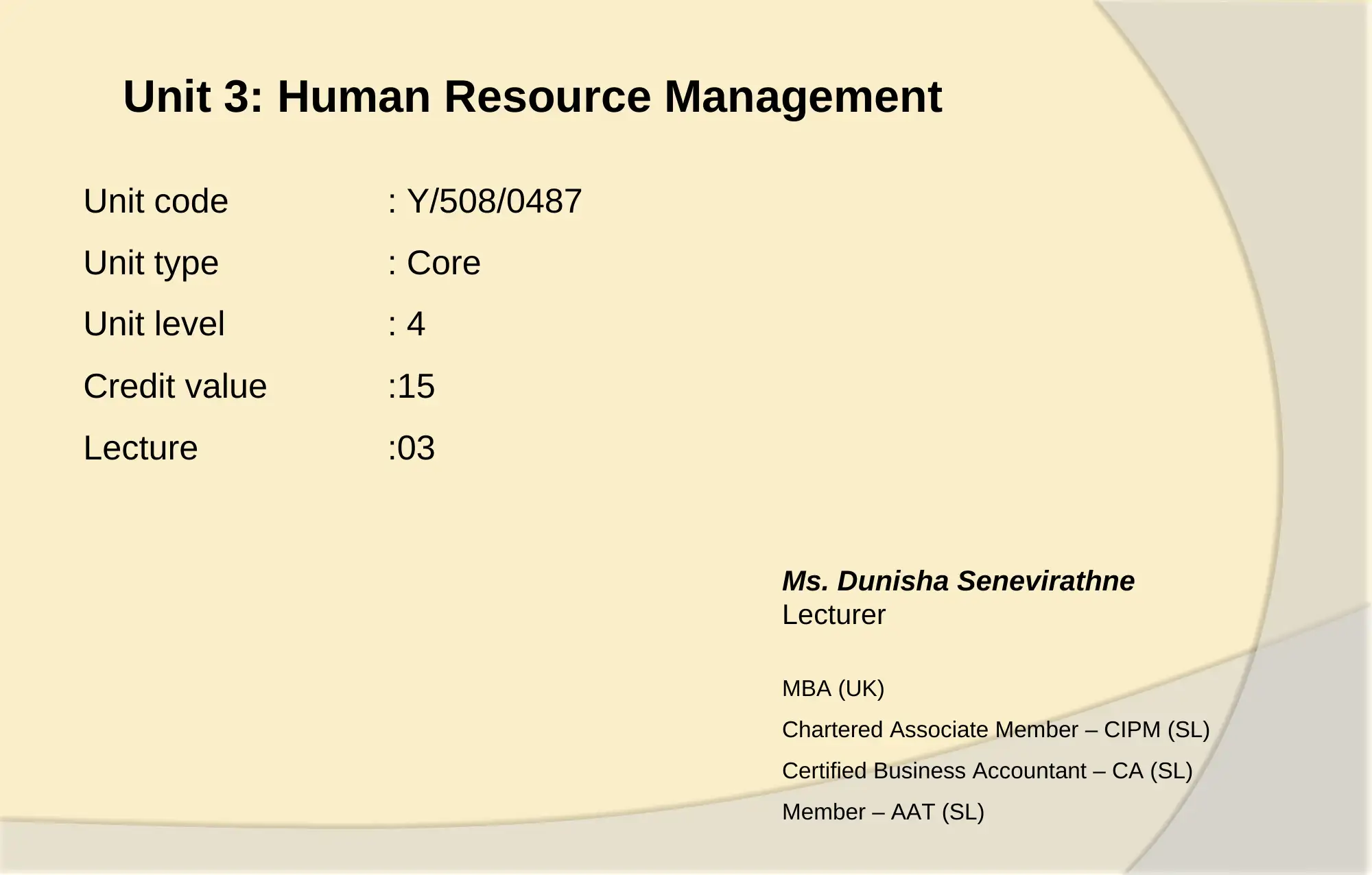
Unit 3: Human Resource Management
Unit code : Y/508/0487
Unit type : Core
Unit level : 4
Credit value :15
Lecture :03
Ms. Dunisha Senevirathne
Lecturer
MBA (UK)
Chartered Associate Member – CIPM (SL)
Certified Business Accountant – CA (SL)
Member – AAT (SL)
Unit code : Y/508/0487
Unit type : Core
Unit level : 4
Credit value :15
Lecture :03
Ms. Dunisha Senevirathne
Lecturer
MBA (UK)
Chartered Associate Member – CIPM (SL)
Certified Business Accountant – CA (SL)
Member – AAT (SL)
Secure Best Marks with AI Grader
Need help grading? Try our AI Grader for instant feedback on your assignments.
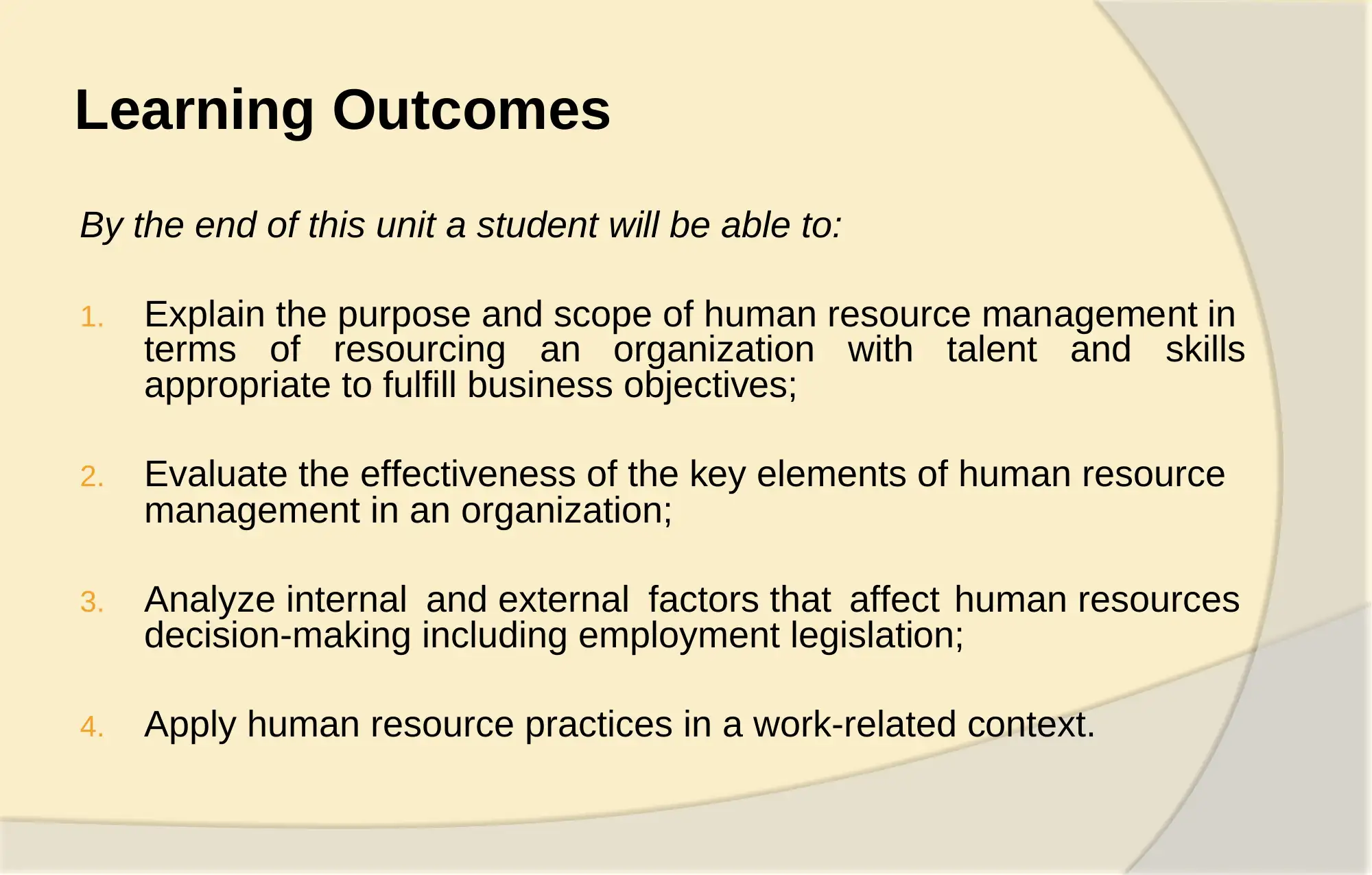
Learning Outcomes
By the end of this unit a student will be able to:
1. Explain the purpose and scope of human resource management in
terms of resourcing an organization with talent and skills
appropriate to fulfill business objectives;
2. Evaluate the effectiveness of the key elements of human resource
management in an organization;
3. Analyze internal and external factors that affect human resources
decision-making including employment legislation;
4. Apply human resource practices in a work-related context.
By the end of this unit a student will be able to:
1. Explain the purpose and scope of human resource management in
terms of resourcing an organization with talent and skills
appropriate to fulfill business objectives;
2. Evaluate the effectiveness of the key elements of human resource
management in an organization;
3. Analyze internal and external factors that affect human resources
decision-making including employment legislation;
4. Apply human resource practices in a work-related context.
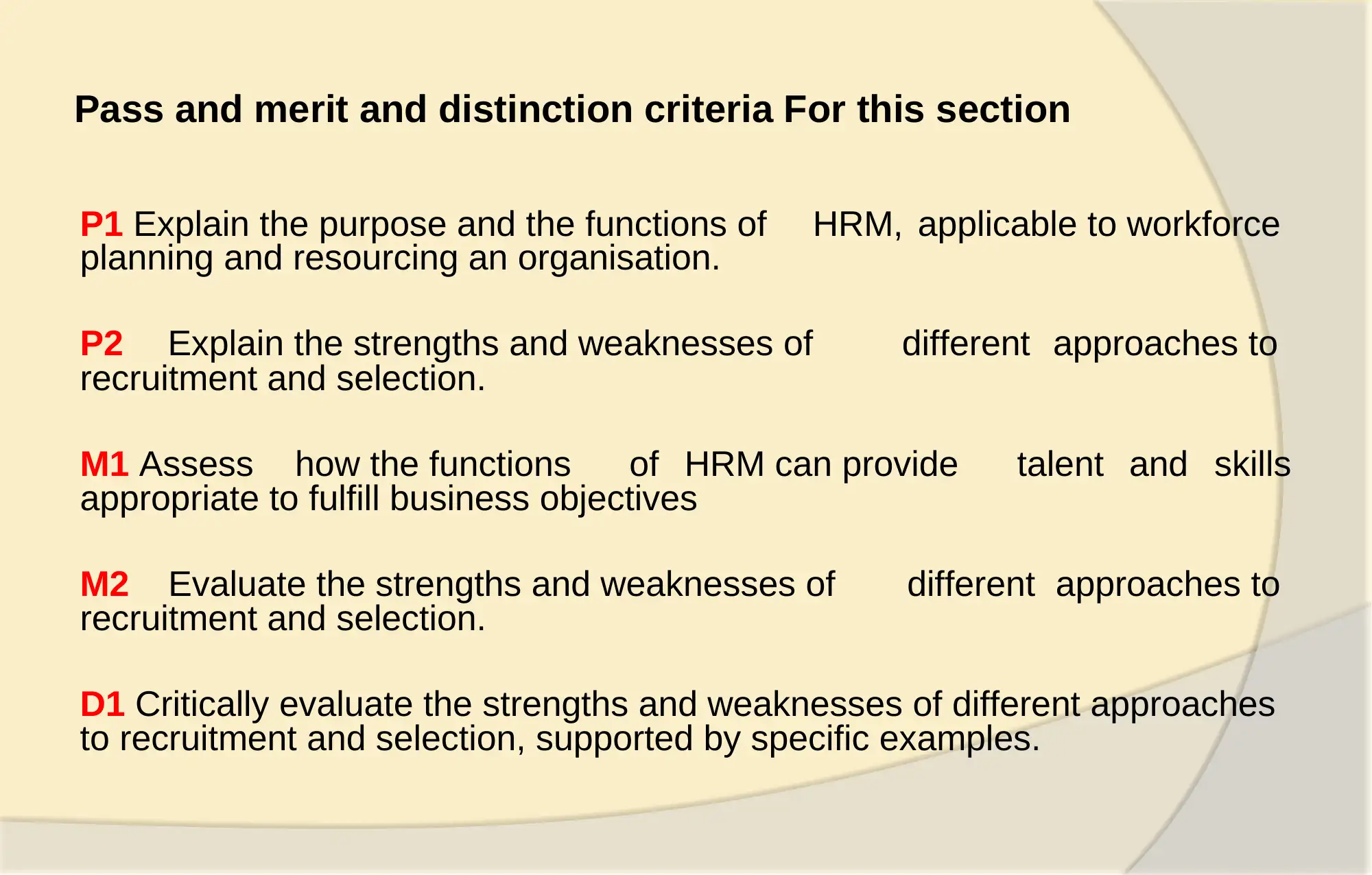
Pass and merit and distinction criteria For this section
P1 Explain the purpose and the functions of HRM, applicable to workforce
planning and resourcing an organisation.
P2 Explain the strengths and weaknesses of different approaches to
recruitment and selection.
M1 Assess how the functions of HRM can provide talent and skills
appropriate to fulfill business objectives
M2 Evaluate the strengths and weaknesses of different approaches to
recruitment and selection.
D1 Critically evaluate the strengths and weaknesses of different approaches
to recruitment and selection, supported by specific examples.
P1 Explain the purpose and the functions of HRM, applicable to workforce
planning and resourcing an organisation.
P2 Explain the strengths and weaknesses of different approaches to
recruitment and selection.
M1 Assess how the functions of HRM can provide talent and skills
appropriate to fulfill business objectives
M2 Evaluate the strengths and weaknesses of different approaches to
recruitment and selection.
D1 Critically evaluate the strengths and weaknesses of different approaches
to recruitment and selection, supported by specific examples.
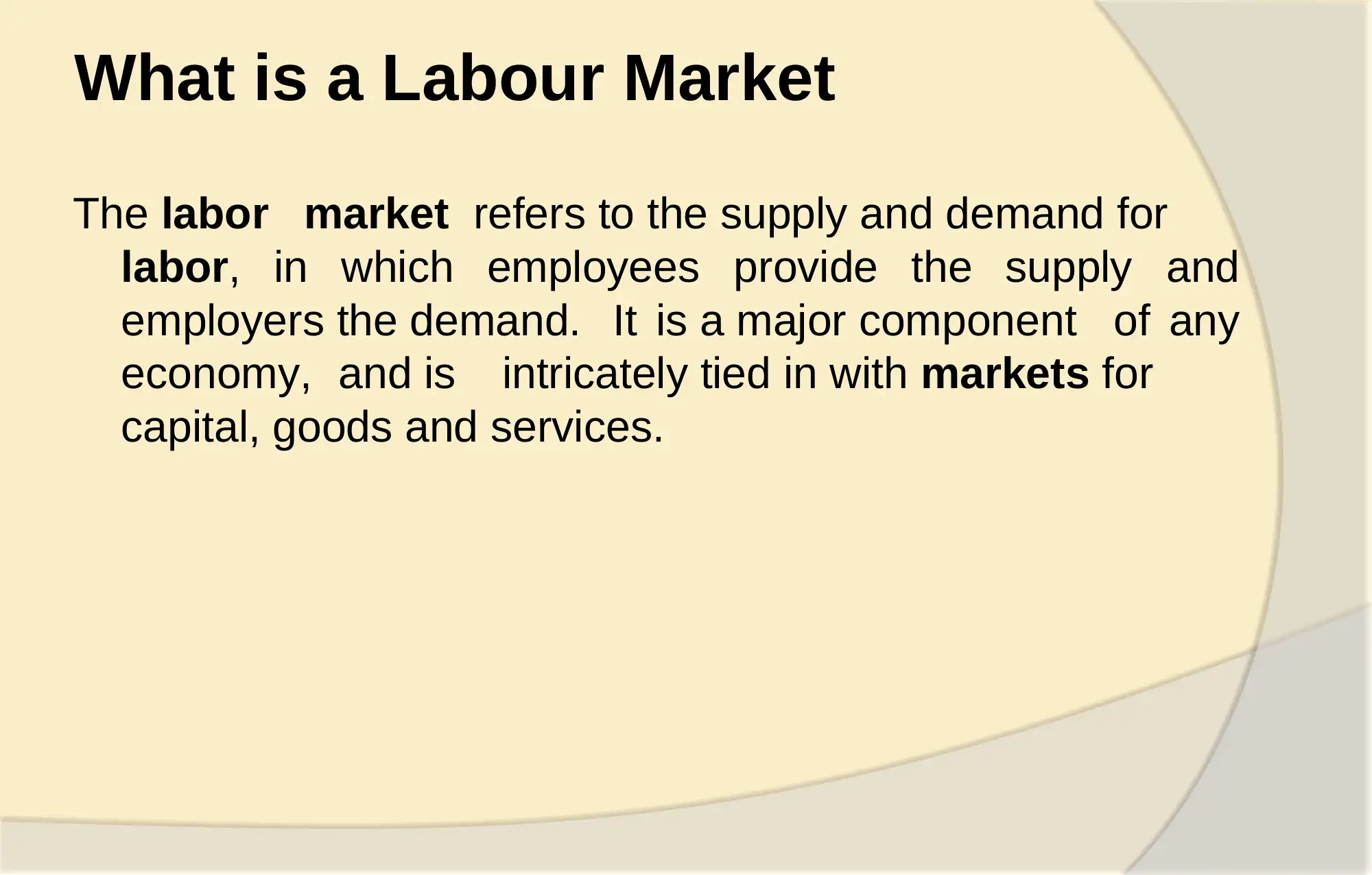
What is a Labour Market
The labor market refers to the supply and demand for
labor, in which employees provide the supply and
employers the demand. It is a major component of any
economy, and is intricately tied in with markets for
capital, goods and services.
The labor market refers to the supply and demand for
labor, in which employees provide the supply and
employers the demand. It is a major component of any
economy, and is intricately tied in with markets for
capital, goods and services.
Secure Best Marks with AI Grader
Need help grading? Try our AI Grader for instant feedback on your assignments.
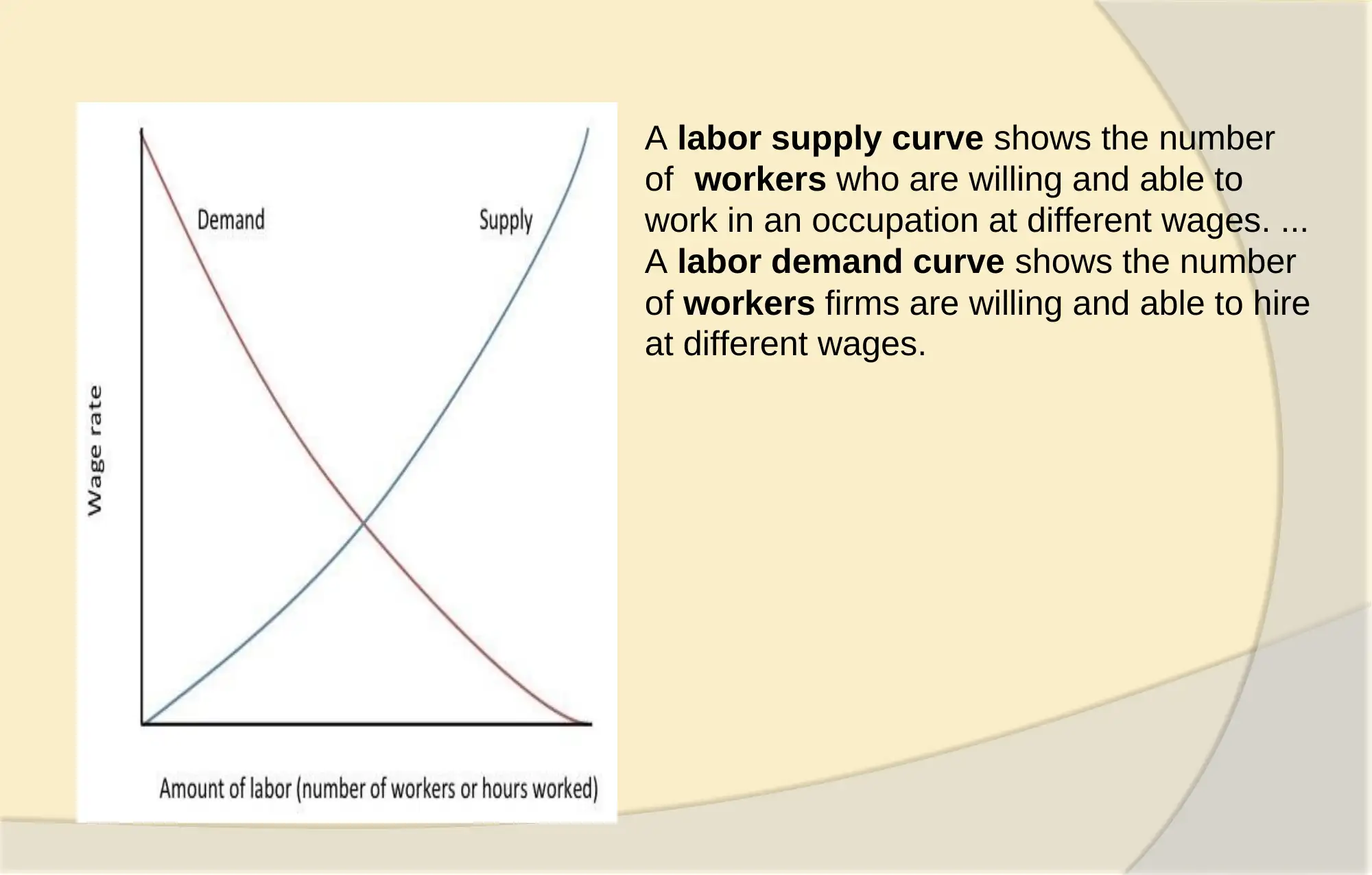
A labor supply curve shows the number
of workers who are willing and able to
work in an occupation at different wages. ...
A labor demand curve shows the number
of workers firms are willing and able to hire
at different wages.
of workers who are willing and able to
work in an occupation at different wages. ...
A labor demand curve shows the number
of workers firms are willing and able to hire
at different wages.
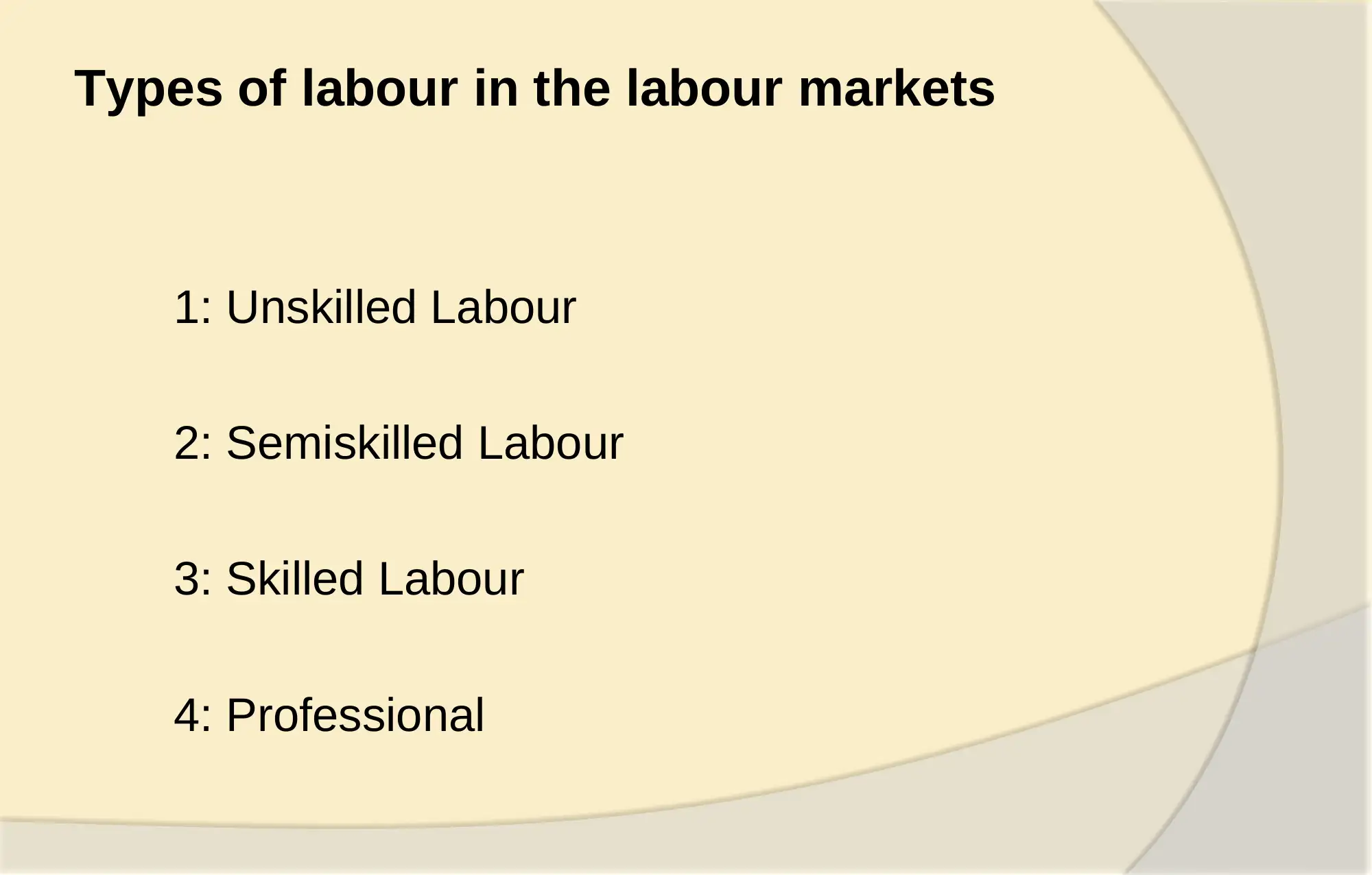
Types of labour in the labour markets
1: Unskilled Labour
2: Semiskilled Labour
3: Skilled Labour
4: Professional
1: Unskilled Labour
2: Semiskilled Labour
3: Skilled Labour
4: Professional
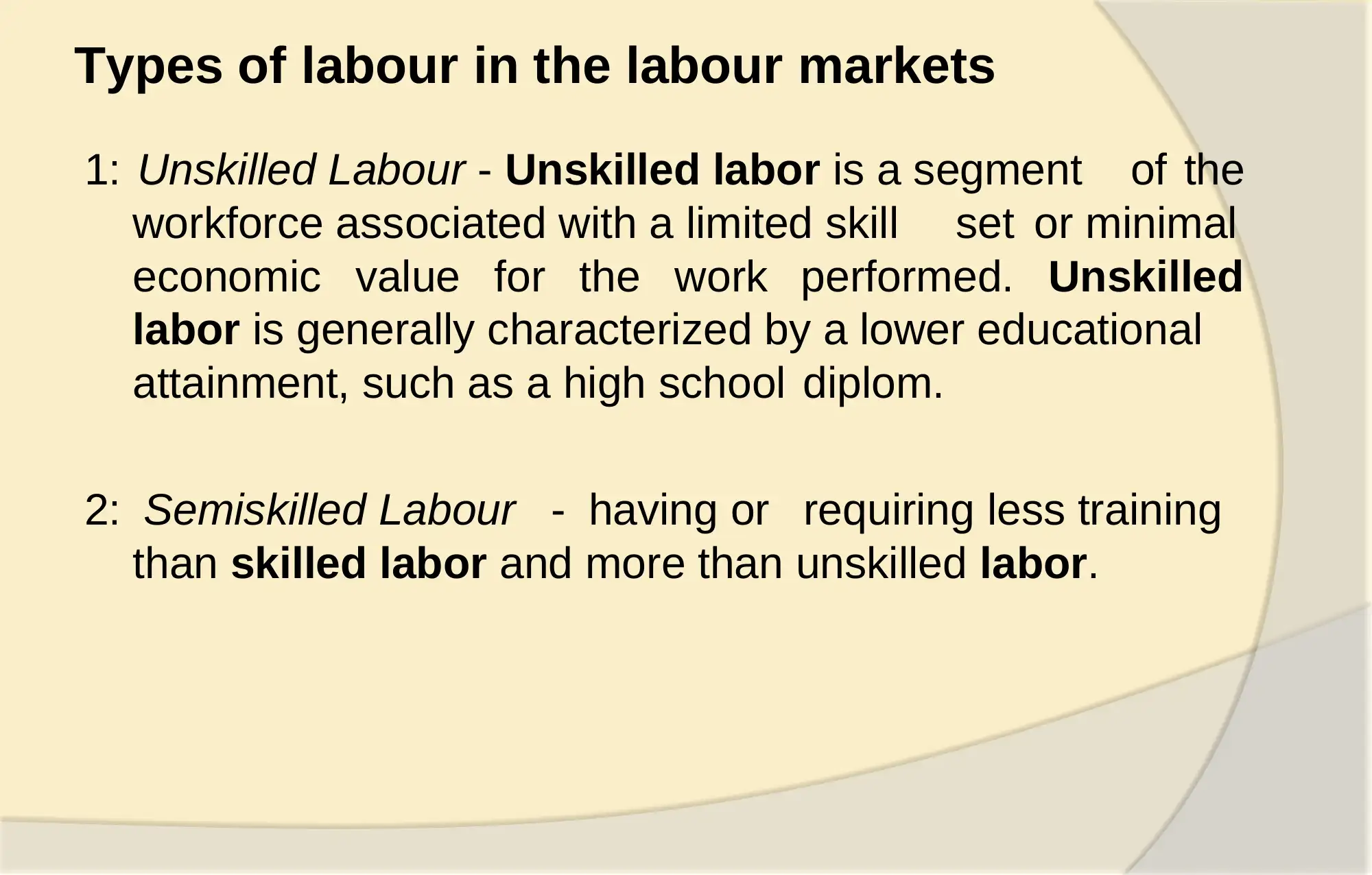
Types of labour in the labour markets
1: Unskilled Labour - Unskilled labor is a segment of the
workforce associated with a limited skill set or minimal
economic value for the work performed. Unskilled
labor is generally characterized by a lower educational
attainment, such as a high school diplom.
2: Semiskilled Labour - having or requiring less training
than skilled labor and more than unskilled labor.
1: Unskilled Labour - Unskilled labor is a segment of the
workforce associated with a limited skill set or minimal
economic value for the work performed. Unskilled
labor is generally characterized by a lower educational
attainment, such as a high school diplom.
2: Semiskilled Labour - having or requiring less training
than skilled labor and more than unskilled labor.
Paraphrase This Document
Need a fresh take? Get an instant paraphrase of this document with our AI Paraphraser
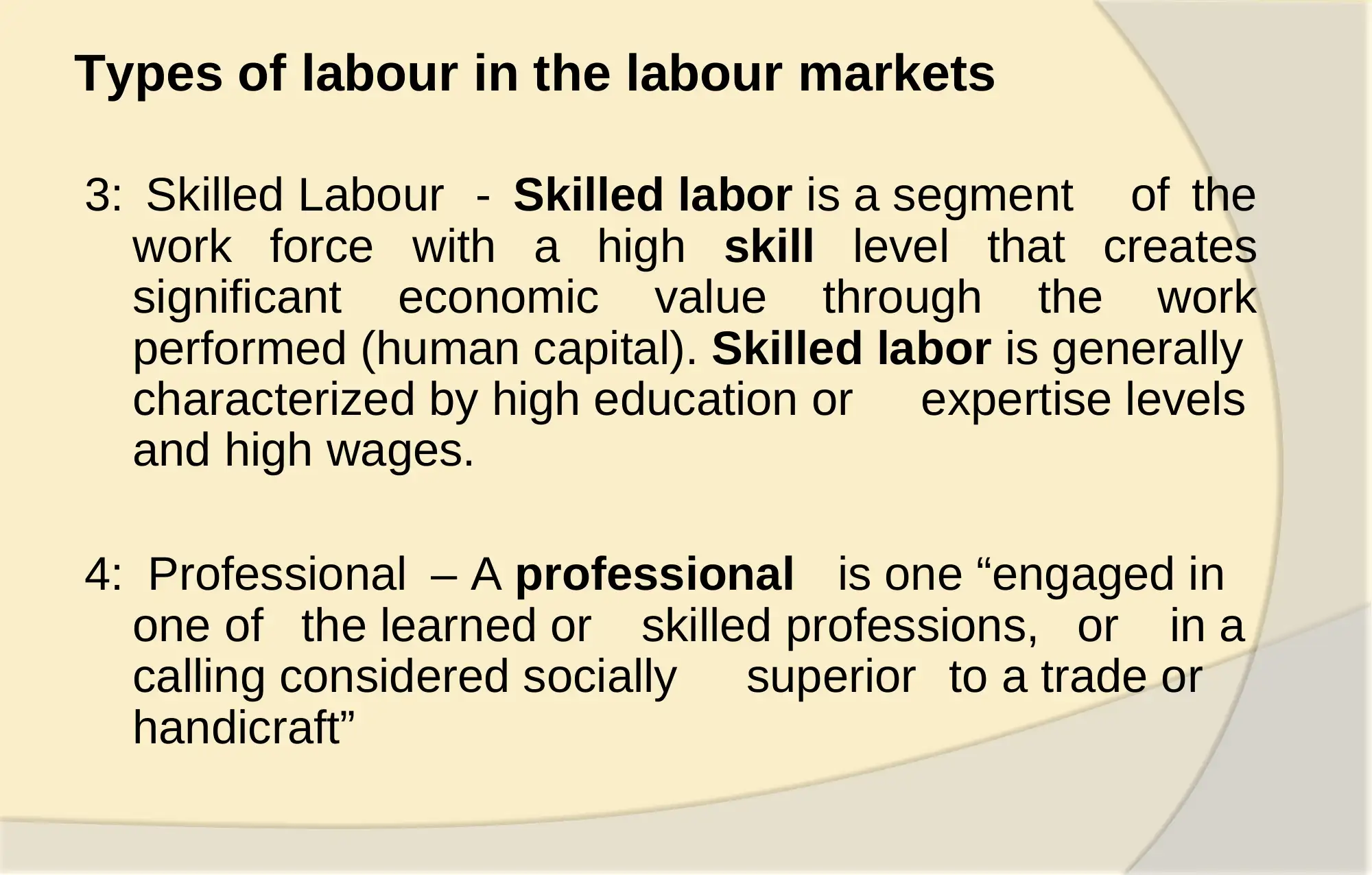
Types of labour in the labour markets
3: Skilled Labour - Skilled labor is a segment of the
work force with a high skill level that creates
significant economic value through the work
performed (human capital). Skilled labor is generally
characterized by high education or expertise levels
and high wages.
4: Professional – A professional is one “engaged in
one of the learned or skilled professions, or in a
calling considered socially superior to a trade or
handicraft”
3: Skilled Labour - Skilled labor is a segment of the
work force with a high skill level that creates
significant economic value through the work
performed (human capital). Skilled labor is generally
characterized by high education or expertise levels
and high wages.
4: Professional – A professional is one “engaged in
one of the learned or skilled professions, or in a
calling considered socially superior to a trade or
handicraft”
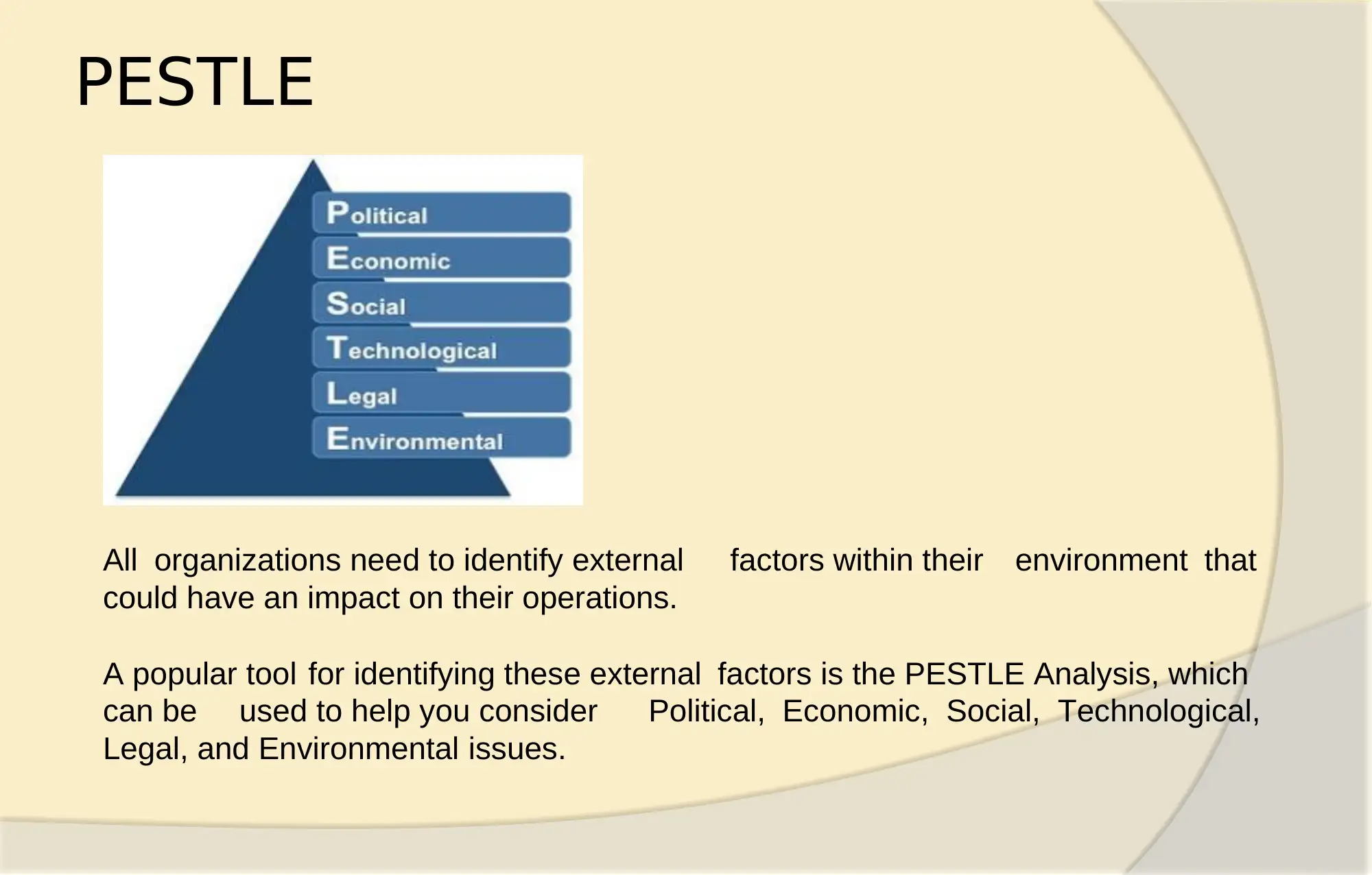
PESTLE
All organizations need to identify external factors within their environment that
could have an impact on their operations.
A popular tool for identifying these external factors is the PESTLE Analysis, which
can be used to help you consider Political, Economic, Social, Technological,
Legal, and Environmental issues.
All organizations need to identify external factors within their environment that
could have an impact on their operations.
A popular tool for identifying these external factors is the PESTLE Analysis, which
can be used to help you consider Political, Economic, Social, Technological,
Legal, and Environmental issues.
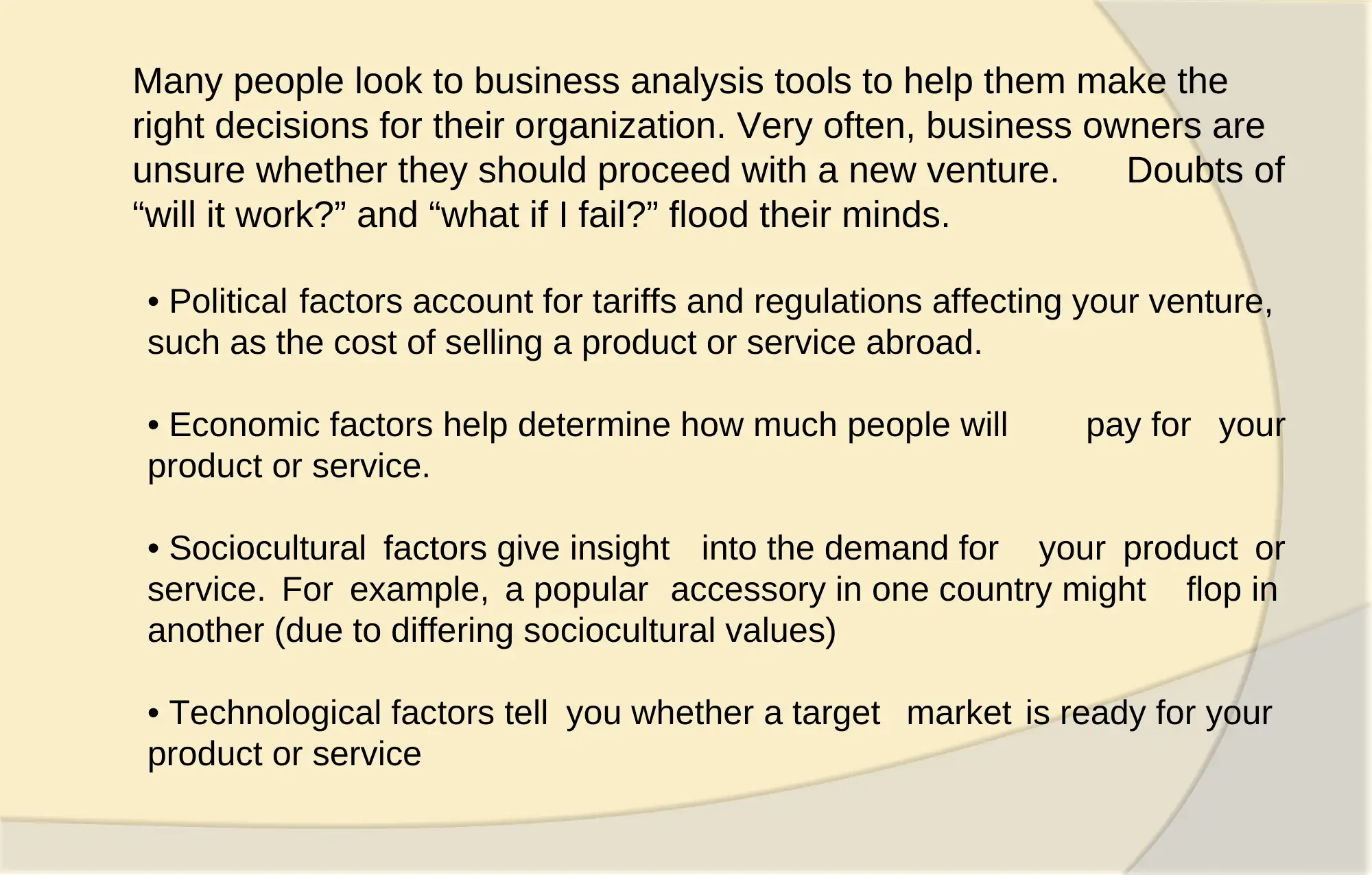
Many people look to business analysis tools to help them make the
right decisions for their organization. Very often, business owners are
unsure whether they should proceed with a new venture. Doubts of
“will it work?” and “what if I fail?” flood their minds.
• Political factors account for tariffs and regulations affecting your venture,
such as the cost of selling a product or service abroad.
• Economic factors help determine how much people will pay for your
product or service.
• Sociocultural factors give insight into the demand for your product or
service. For example, a popular accessory in one country might flop in
another (due to differing sociocultural values)
• Technological factors tell you whether a target market is ready for your
product or service
right decisions for their organization. Very often, business owners are
unsure whether they should proceed with a new venture. Doubts of
“will it work?” and “what if I fail?” flood their minds.
• Political factors account for tariffs and regulations affecting your venture,
such as the cost of selling a product or service abroad.
• Economic factors help determine how much people will pay for your
product or service.
• Sociocultural factors give insight into the demand for your product or
service. For example, a popular accessory in one country might flop in
another (due to differing sociocultural values)
• Technological factors tell you whether a target market is ready for your
product or service
Secure Best Marks with AI Grader
Need help grading? Try our AI Grader for instant feedback on your assignments.
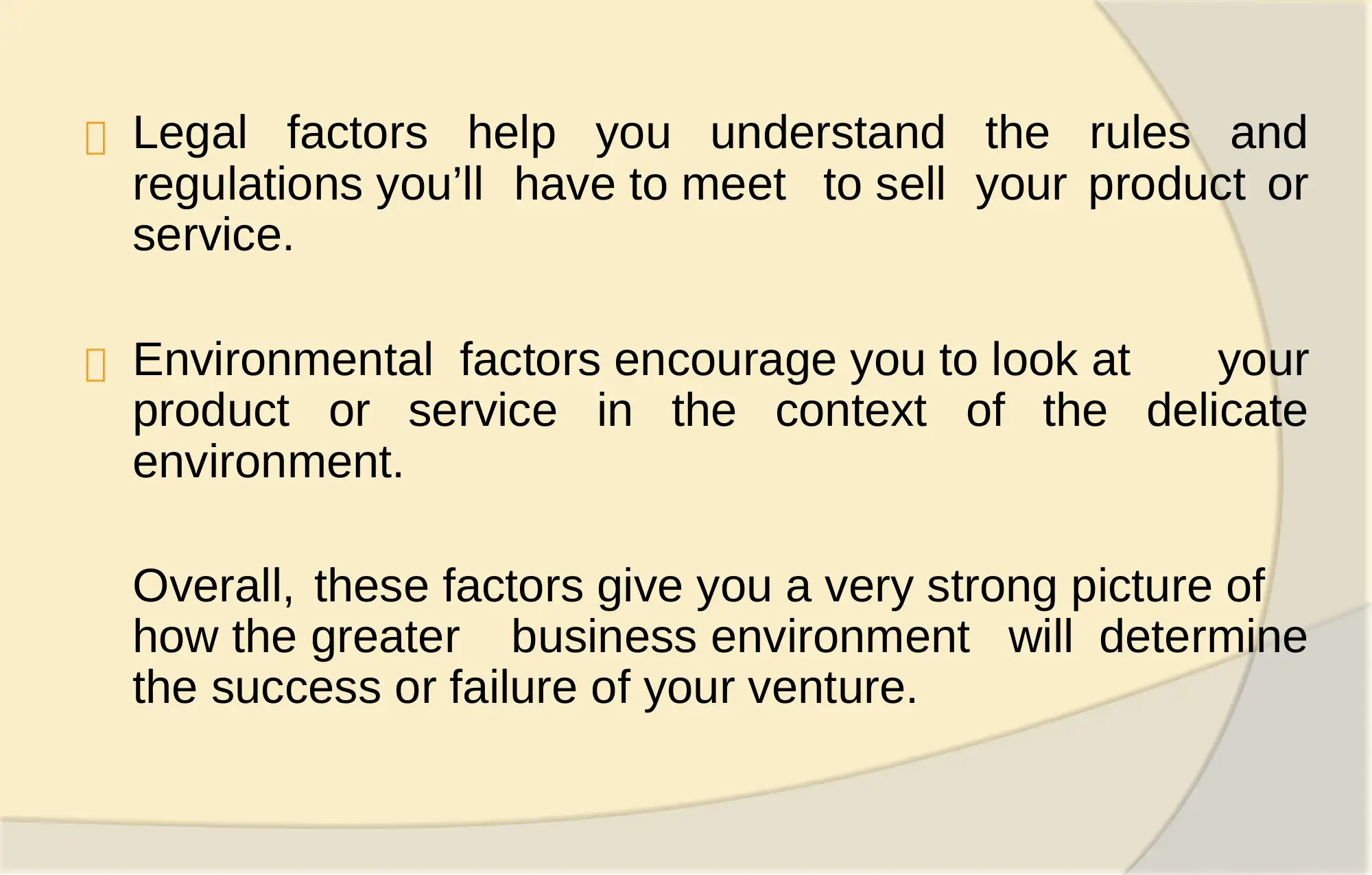
Legal factors help you understand the rules and
regulations you’ll have to meet to sell your product or
service.
Environmental factors encourage you to look at your
product or service in the context of the delicate
environment.
Overall, these factors give you a very strong picture of
how the greater business environment will determine
the success or failure of your venture.
regulations you’ll have to meet to sell your product or
service.
Environmental factors encourage you to look at your
product or service in the context of the delicate
environment.
Overall, these factors give you a very strong picture of
how the greater business environment will determine
the success or failure of your venture.
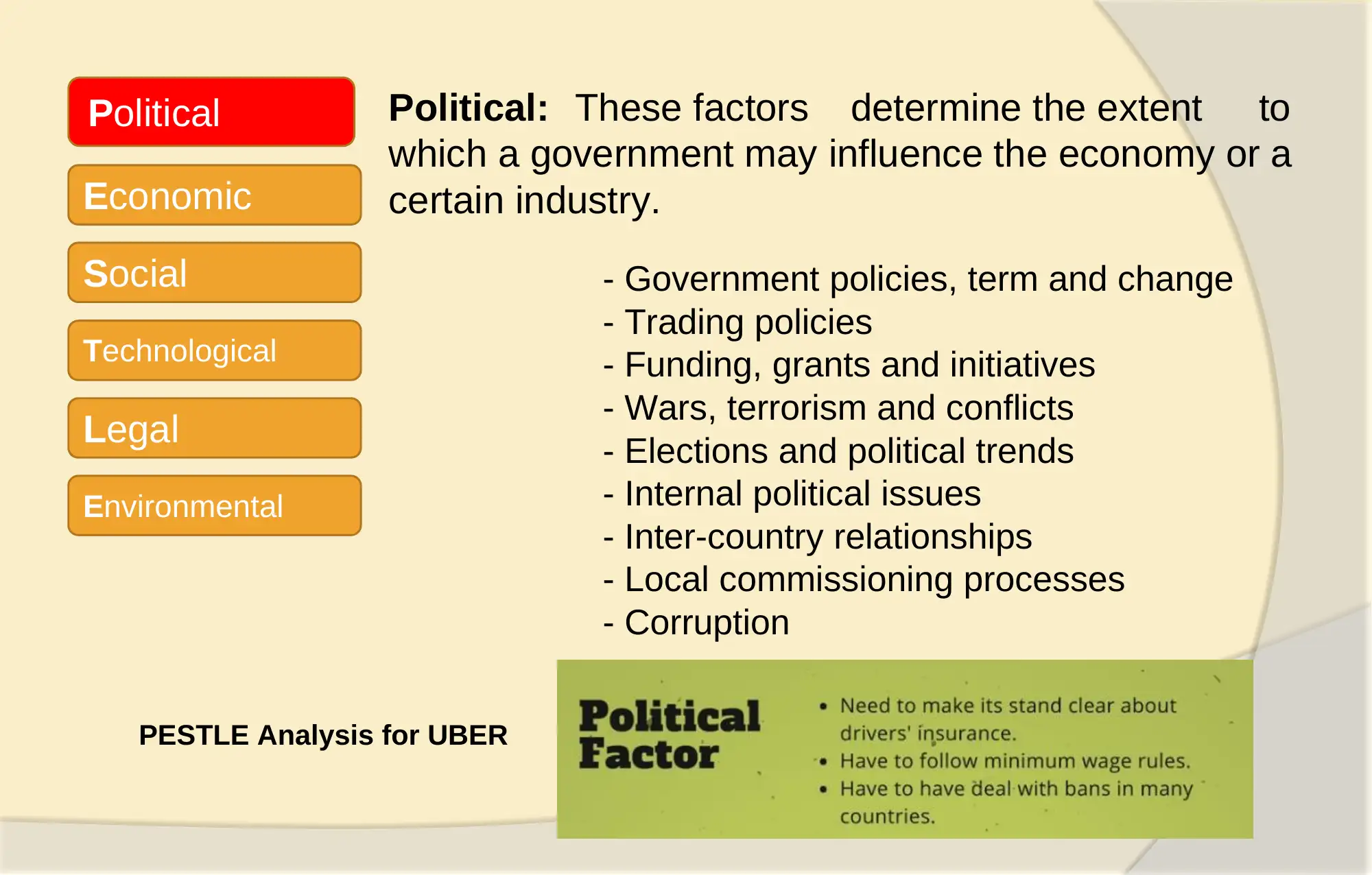
Political
Economic
Social
Technological
Legal
Environmental
Political: These factors determine the extent to
which a government may influence the economy or a
certain industry.
- Government policies, term and change
- Trading policies
- Funding, grants and initiatives
- Wars, terrorism and conflicts
- Elections and political trends
- Internal political issues
- Inter-country relationships
- Local commissioning processes
- Corruption
PESTLE Analysis for UBER
Economic
Social
Technological
Legal
Environmental
Political: These factors determine the extent to
which a government may influence the economy or a
certain industry.
- Government policies, term and change
- Trading policies
- Funding, grants and initiatives
- Wars, terrorism and conflicts
- Elections and political trends
- Internal political issues
- Inter-country relationships
- Local commissioning processes
- Corruption
PESTLE Analysis for UBER
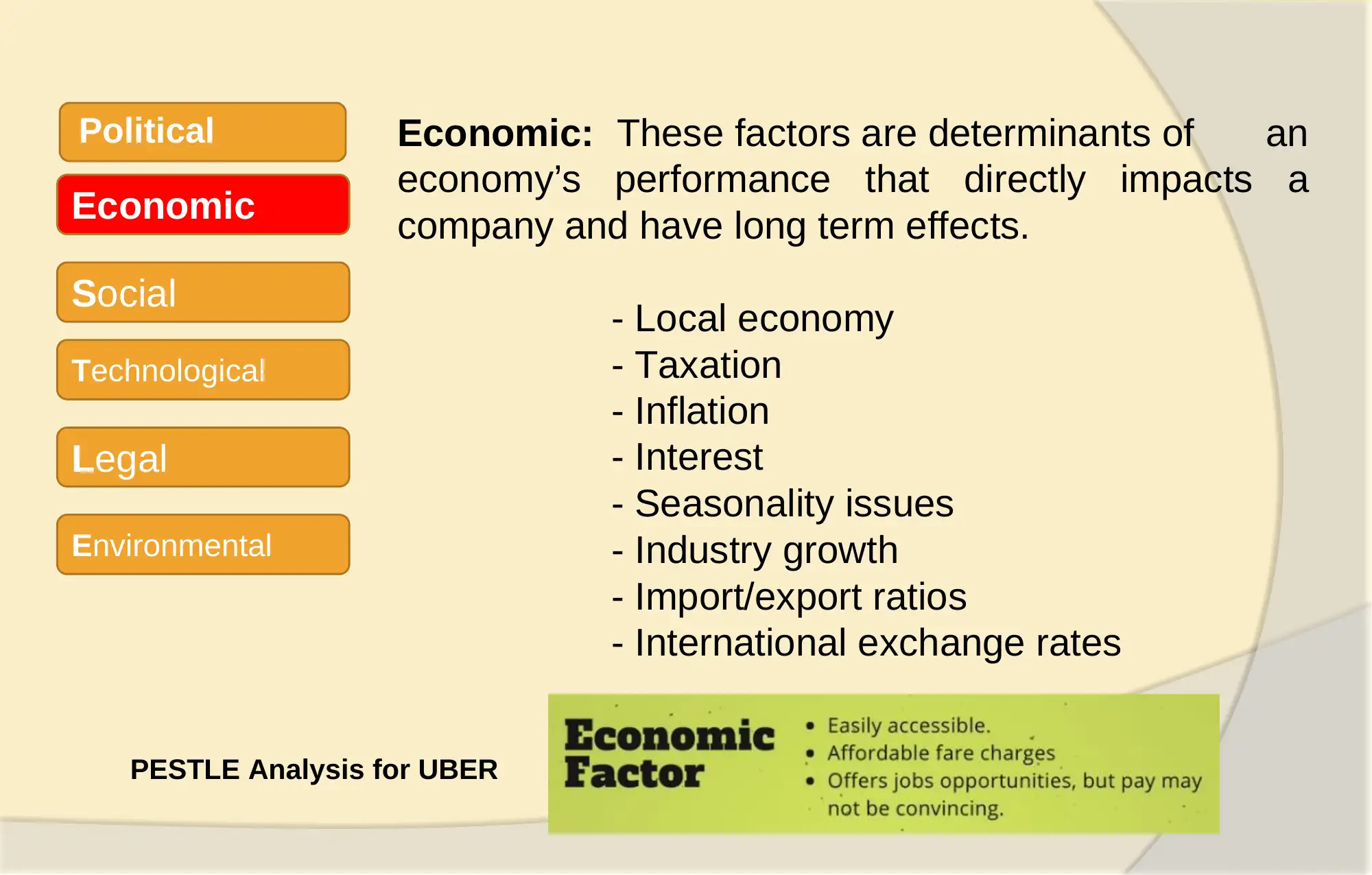
Economic
Social
Technological
Legal
Environmental
Economic: These factors are determinants of an
economy’s performance that directly impacts a
company and have long term effects.
- Local economy
- Taxation
- Inflation
- Interest
- Seasonality issues
- Industry growth
- Import/export ratios
- International exchange rates
Political
PESTLE Analysis for UBER
Social
Technological
Legal
Environmental
Economic: These factors are determinants of an
economy’s performance that directly impacts a
company and have long term effects.
- Local economy
- Taxation
- Inflation
- Interest
- Seasonality issues
- Industry growth
- Import/export ratios
- International exchange rates
Political
PESTLE Analysis for UBER
Paraphrase This Document
Need a fresh take? Get an instant paraphrase of this document with our AI Paraphraser
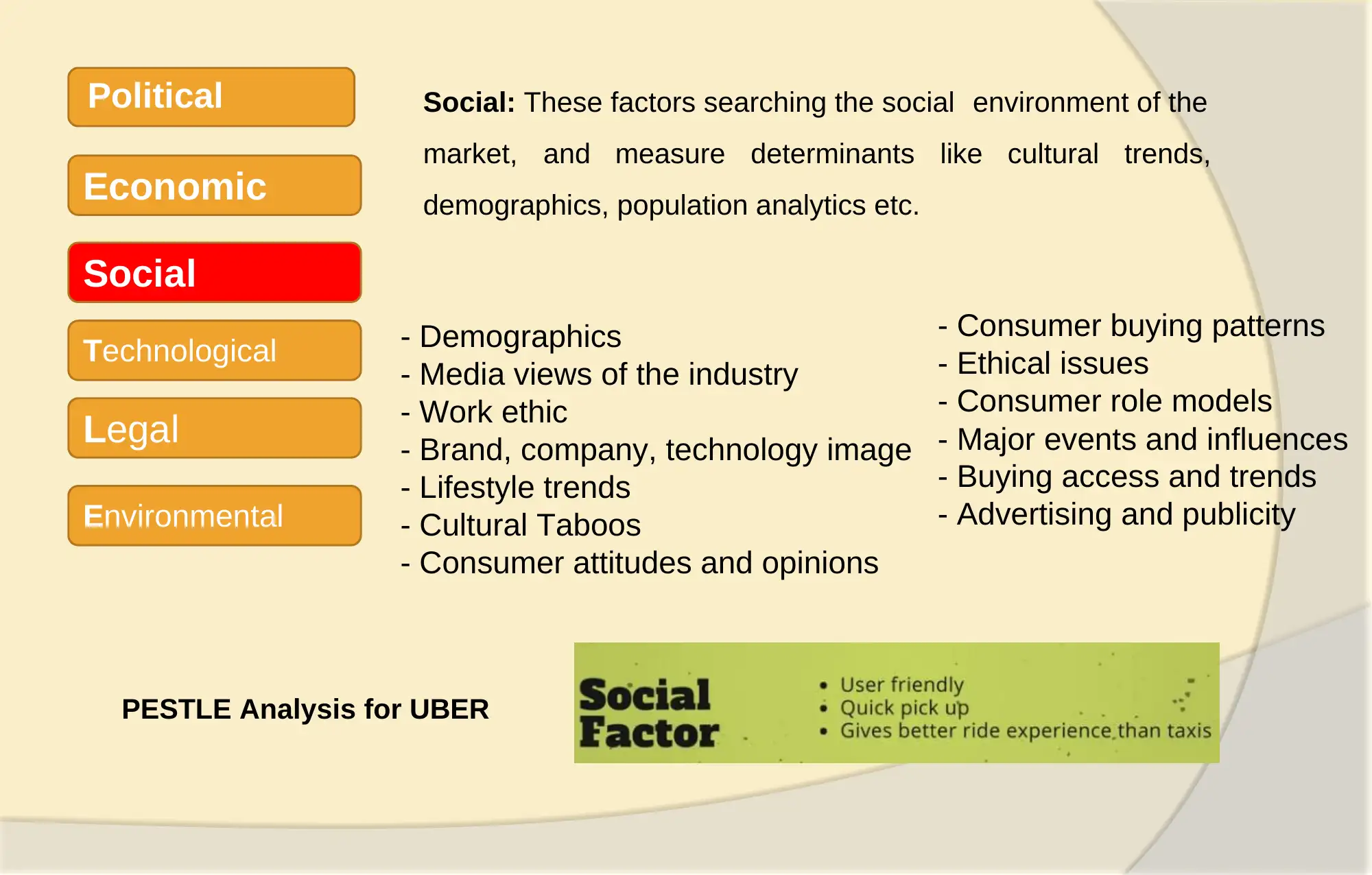
Political
Economic
Social
Technological
Legal
Environmental
Social: These factors searching the social environment of the
market, and measure determinants like cultural trends,
demographics, population analytics etc.
- Demographics
- Media views of the industry
- Work ethic
- Brand, company, technology image
- Lifestyle trends
- Cultural Taboos
- Consumer attitudes and opinions
- Consumer buying patterns
- Ethical issues
- Consumer role models
- Major events and influences
- Buying access and trends
- Advertising and publicity
PESTLE Analysis for UBER
Economic
Social
Technological
Legal
Environmental
Social: These factors searching the social environment of the
market, and measure determinants like cultural trends,
demographics, population analytics etc.
- Demographics
- Media views of the industry
- Work ethic
- Brand, company, technology image
- Lifestyle trends
- Cultural Taboos
- Consumer attitudes and opinions
- Consumer buying patterns
- Ethical issues
- Consumer role models
- Major events and influences
- Buying access and trends
- Advertising and publicity
PESTLE Analysis for UBER
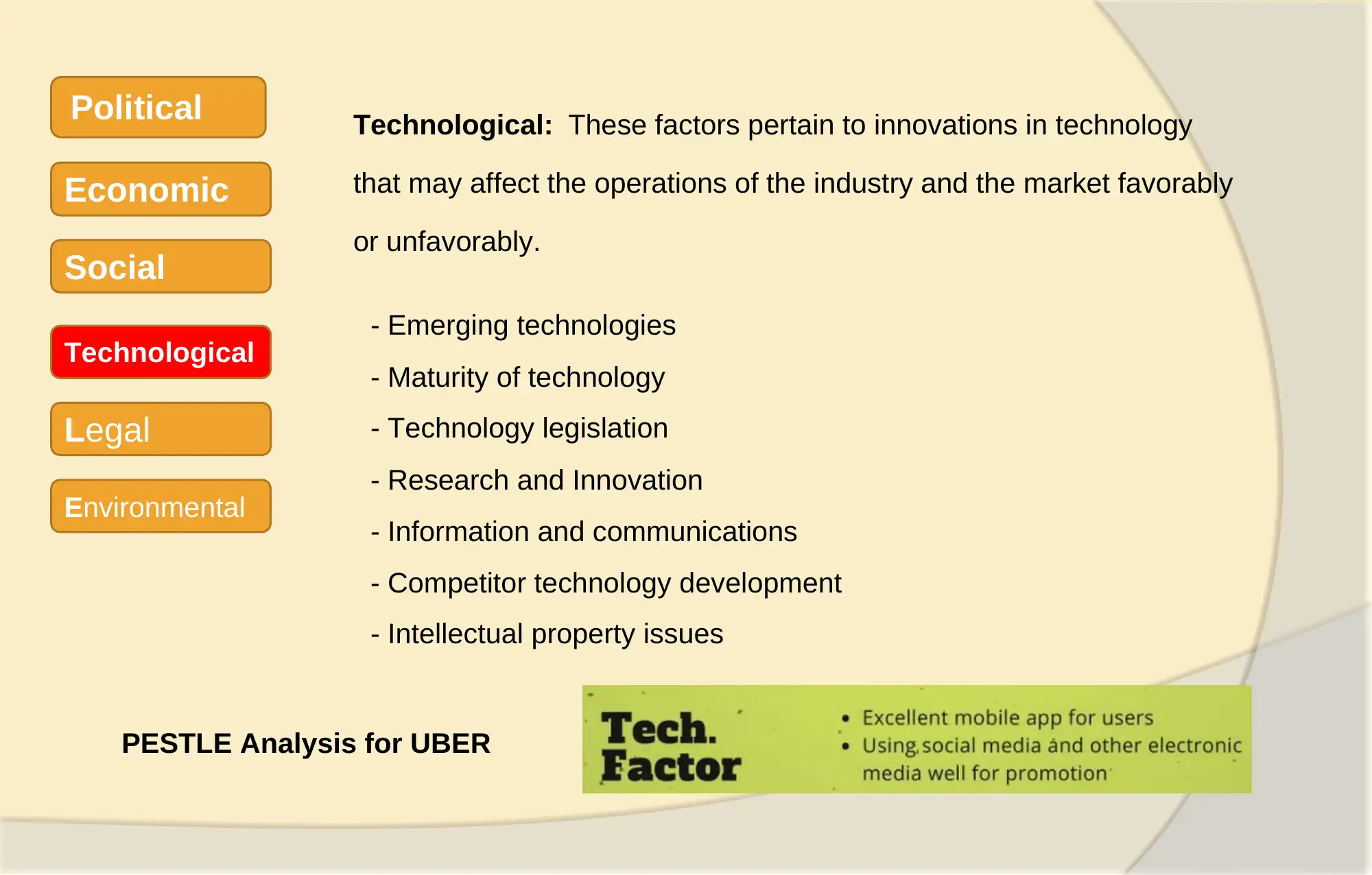
Political
Economic
Social
Technological
Legal
Environmental
Technological: These factors pertain to innovations in technology
that may affect the operations of the industry and the market favorably
or unfavorably.
- Emerging technologies
- Maturity of technology
- Technology legislation
- Research and Innovation
- Information and communications
- Competitor technology development
- Intellectual property issues
PESTLE Analysis for UBER
Economic
Social
Technological
Legal
Environmental
Technological: These factors pertain to innovations in technology
that may affect the operations of the industry and the market favorably
or unfavorably.
- Emerging technologies
- Maturity of technology
- Technology legislation
- Research and Innovation
- Information and communications
- Competitor technology development
- Intellectual property issues
PESTLE Analysis for UBER
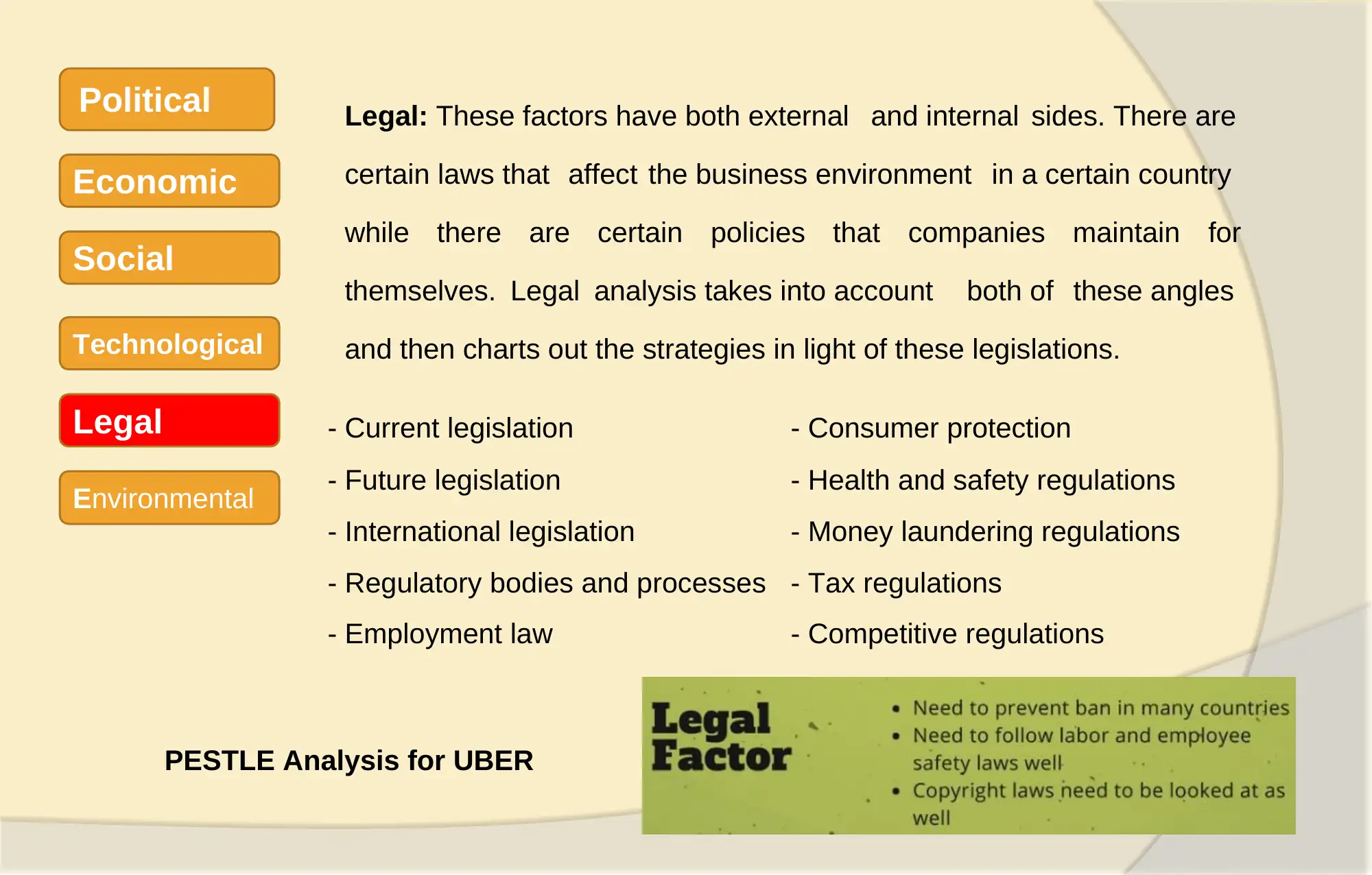
Political
Economic
Social
Technological
Legal
Environmental
Legal: These factors have both external and internal sides. There are
certain laws that affect the business environment in a certain country
while there are certain policies that companies maintain for
themselves. Legal analysis takes into account both of these angles
and then charts out the strategies in light of these legislations.
- Current legislation
- Future legislation
- International legislation
- Regulatory bodies and processes
- Employment law
- Consumer protection
- Health and safety regulations
- Money laundering regulations
- Tax regulations
- Competitive regulations
PESTLE Analysis for UBER
Economic
Social
Technological
Legal
Environmental
Legal: These factors have both external and internal sides. There are
certain laws that affect the business environment in a certain country
while there are certain policies that companies maintain for
themselves. Legal analysis takes into account both of these angles
and then charts out the strategies in light of these legislations.
- Current legislation
- Future legislation
- International legislation
- Regulatory bodies and processes
- Employment law
- Consumer protection
- Health and safety regulations
- Money laundering regulations
- Tax regulations
- Competitive regulations
PESTLE Analysis for UBER
Secure Best Marks with AI Grader
Need help grading? Try our AI Grader for instant feedback on your assignments.
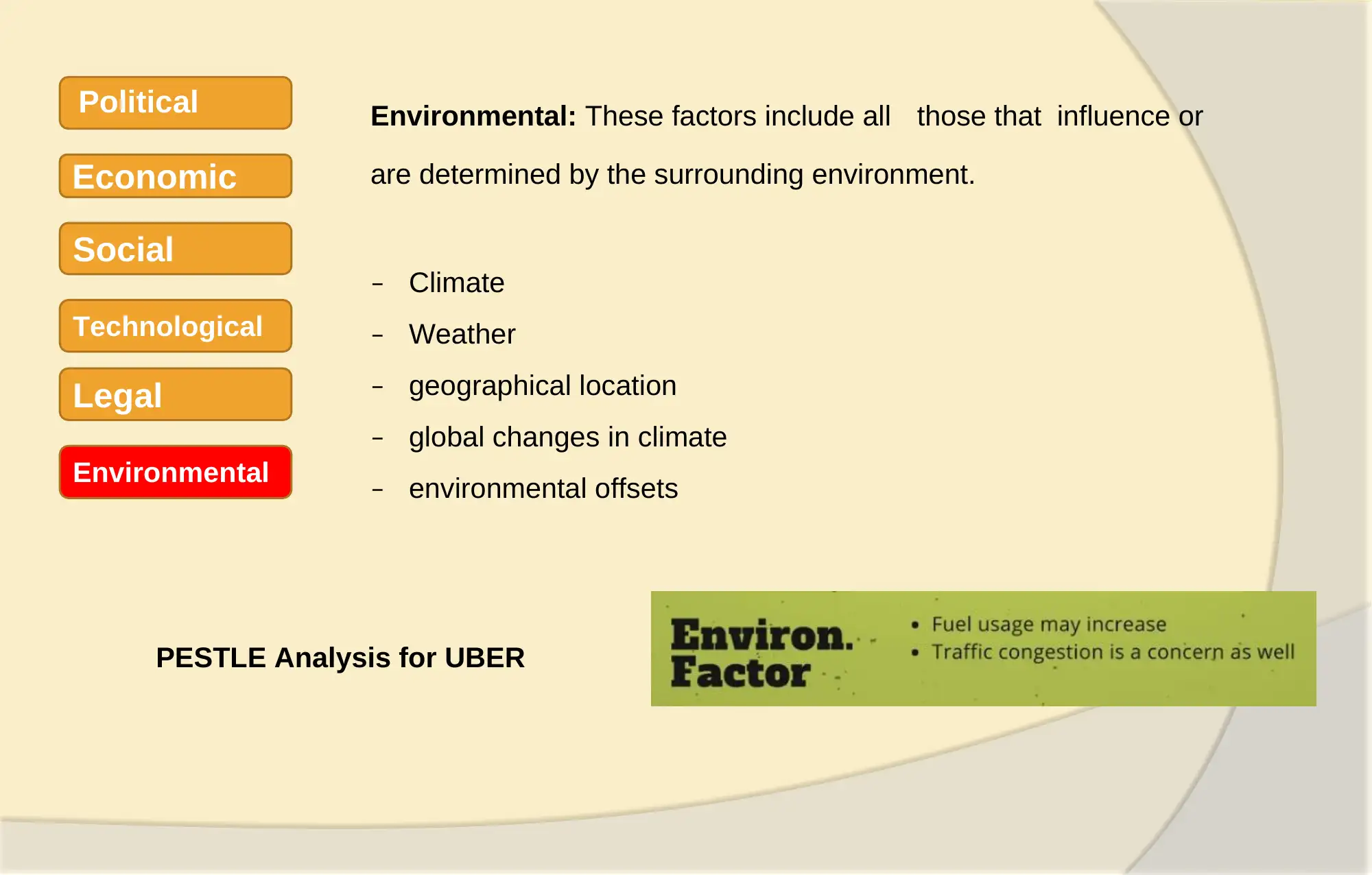
Political
Economic
Social
Technological
Legal
Environmental
Environmental: These factors include all those that influence or
are determined by the surrounding environment.
– Climate
– Weather
– geographical location
– global changes in climate
– environmental offsets
PESTLE Analysis for UBER
Economic
Social
Technological
Legal
Environmental
Environmental: These factors include all those that influence or
are determined by the surrounding environment.
– Climate
– Weather
– geographical location
– global changes in climate
– environmental offsets
PESTLE Analysis for UBER
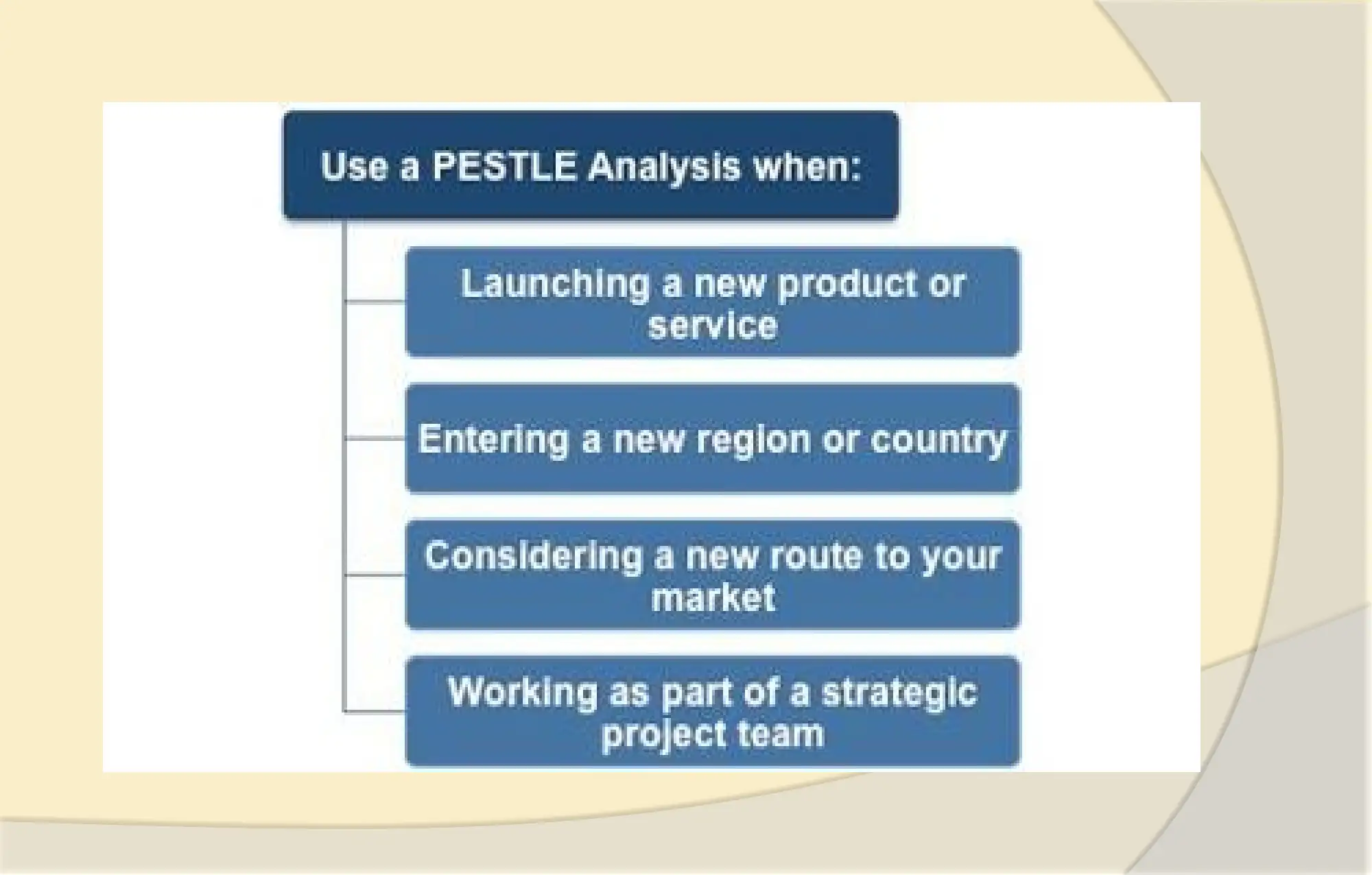
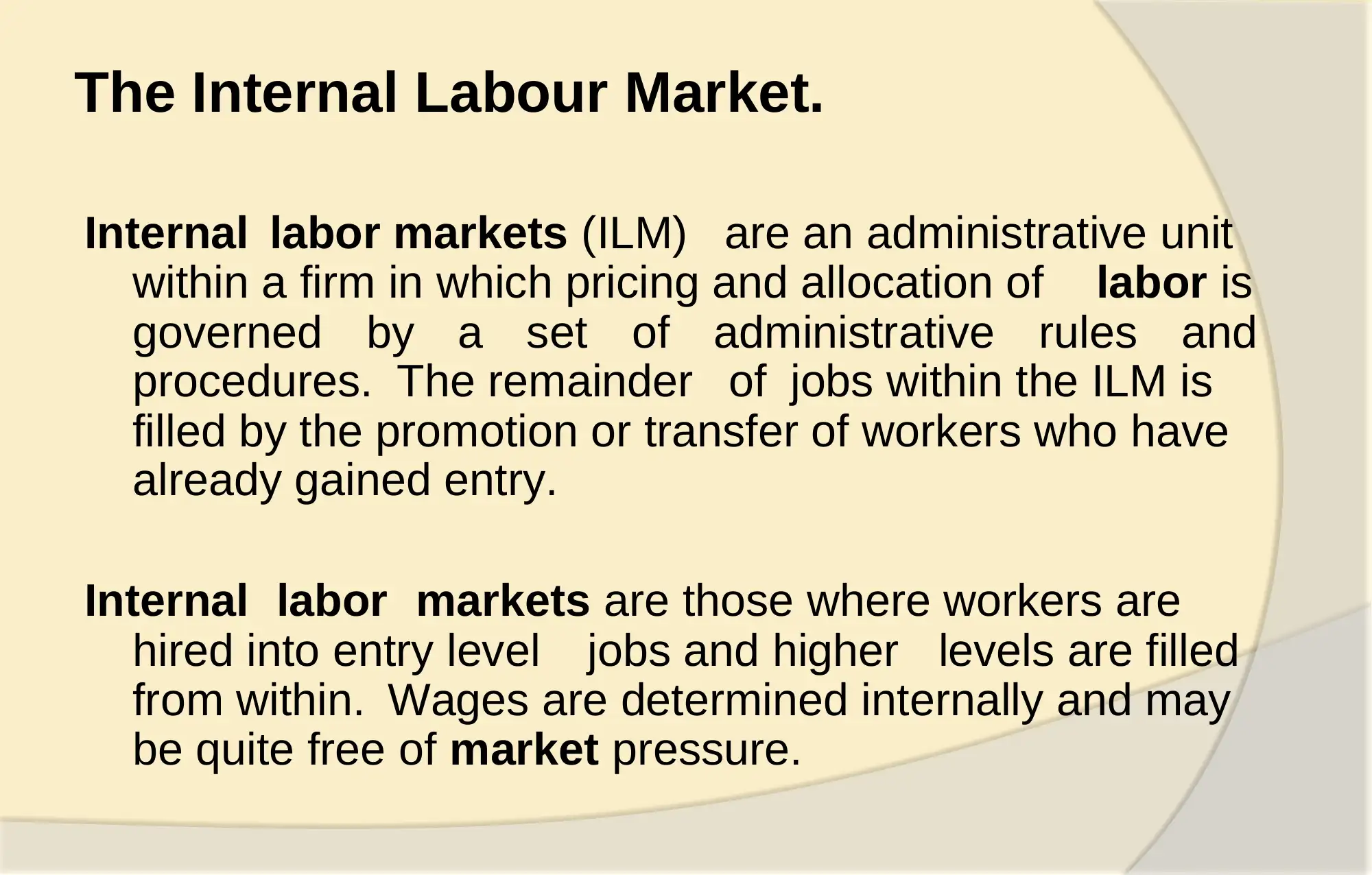
The Internal Labour Market.
Internal labor markets (ILM) are an administrative unit
within a firm in which pricing and allocation of labor is
governed by a set of administrative rules and
procedures. The remainder of jobs within the ILM is
filled by the promotion or transfer of workers who have
already gained entry.
Internal labor markets are those where workers are
hired into entry level jobs and higher levels are filled
from within. Wages are determined internally and may
be quite free of market pressure.
Internal labor markets (ILM) are an administrative unit
within a firm in which pricing and allocation of labor is
governed by a set of administrative rules and
procedures. The remainder of jobs within the ILM is
filled by the promotion or transfer of workers who have
already gained entry.
Internal labor markets are those where workers are
hired into entry level jobs and higher levels are filled
from within. Wages are determined internally and may
be quite free of market pressure.
Paraphrase This Document
Need a fresh take? Get an instant paraphrase of this document with our AI Paraphraser
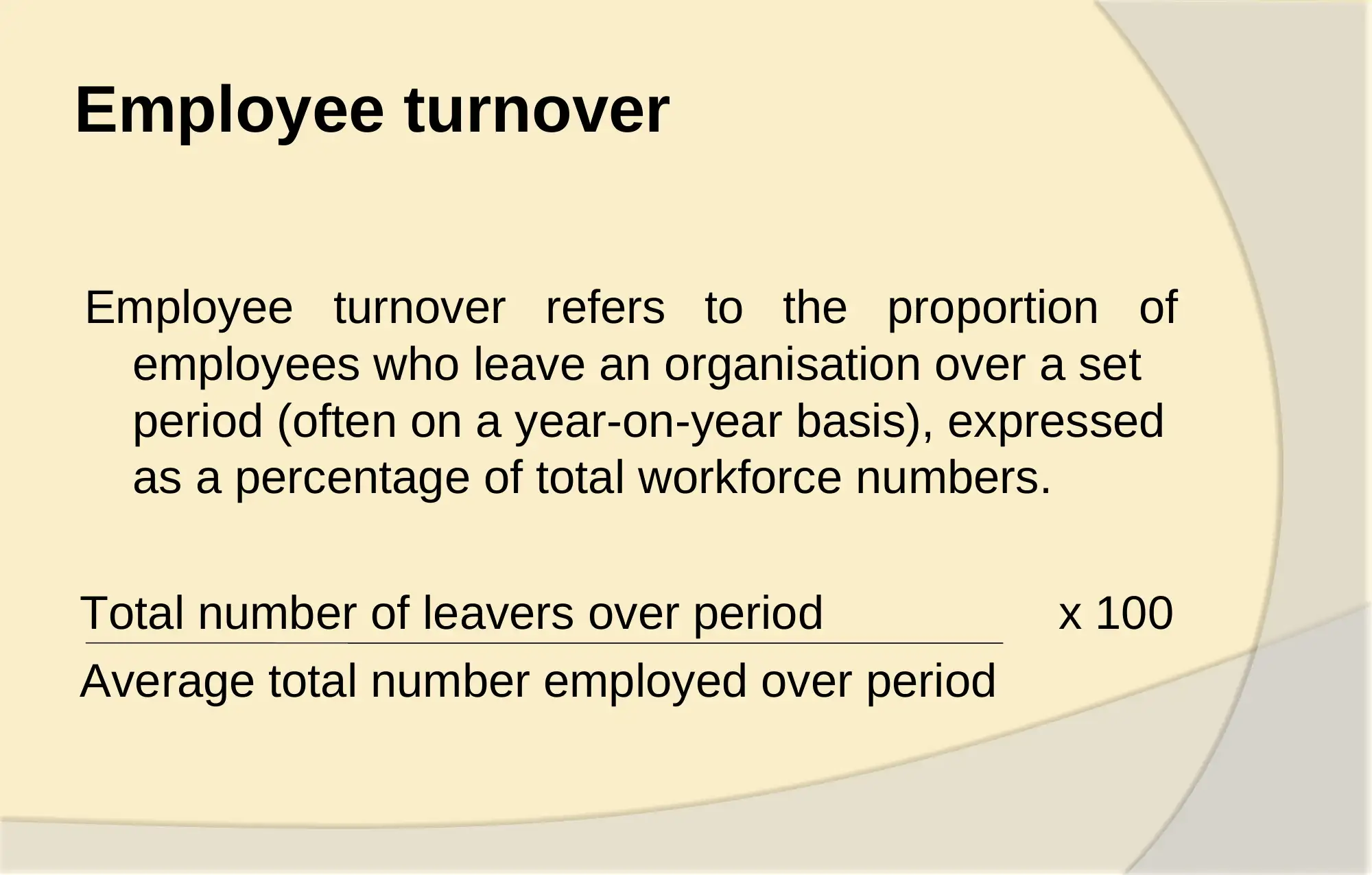
Employee turnover
Employee turnover refers to the proportion of
employees who leave an organisation over a set
period (often on a year-on-year basis), expressed
as a percentage of total workforce numbers.
Total number of leavers over period x 100
Average total number employed over period
Employee turnover refers to the proportion of
employees who leave an organisation over a set
period (often on a year-on-year basis), expressed
as a percentage of total workforce numbers.
Total number of leavers over period x 100
Average total number employed over period
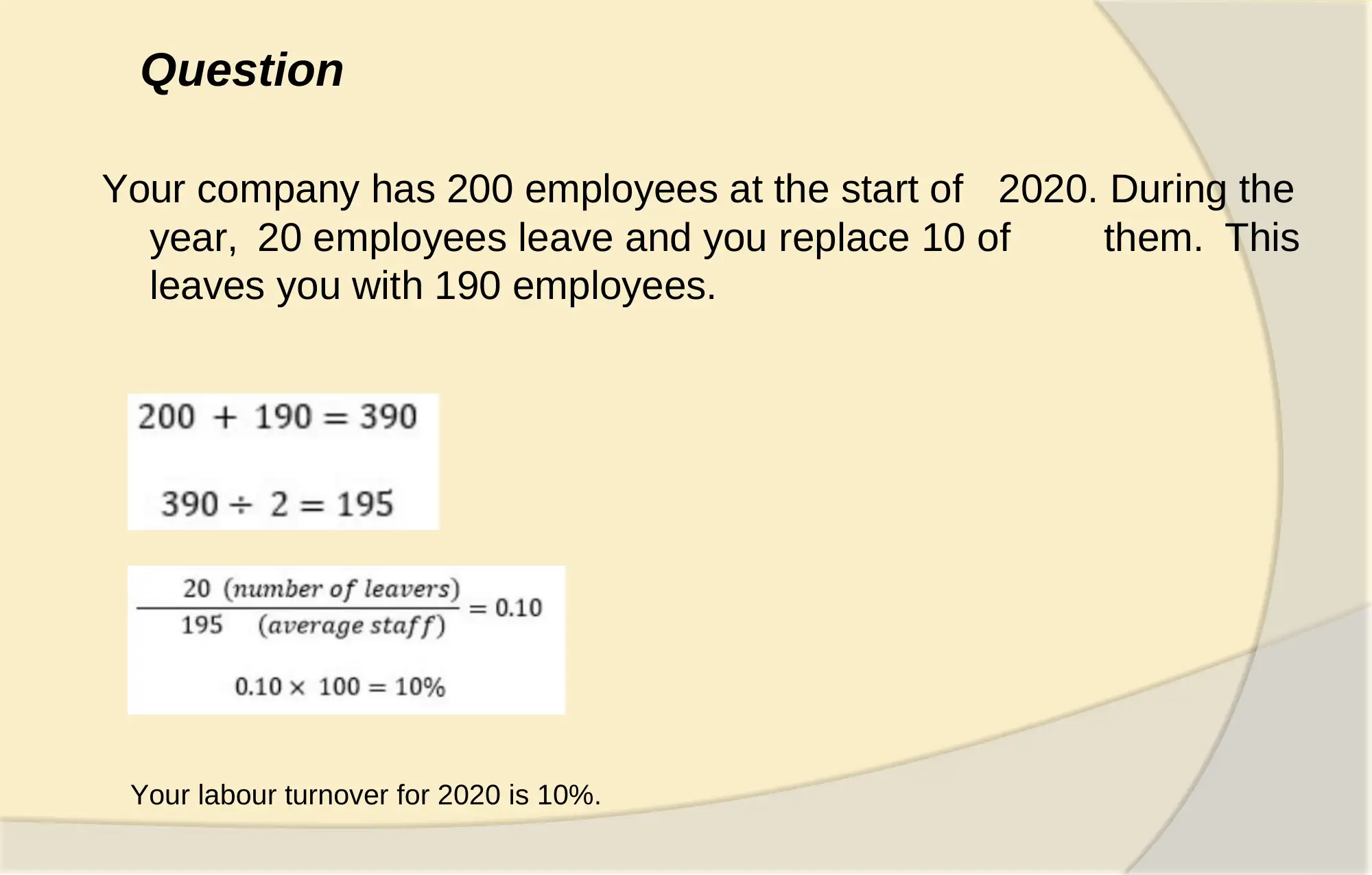
Question
Your company has 200 employees at the start of 2020. During the
year, 20 employees leave and you replace 10 of them. This
leaves you with 190 employees.
Your labour turnover for 2020 is 10%.
Your company has 200 employees at the start of 2020. During the
year, 20 employees leave and you replace 10 of them. This
leaves you with 190 employees.
Your labour turnover for 2020 is 10%.
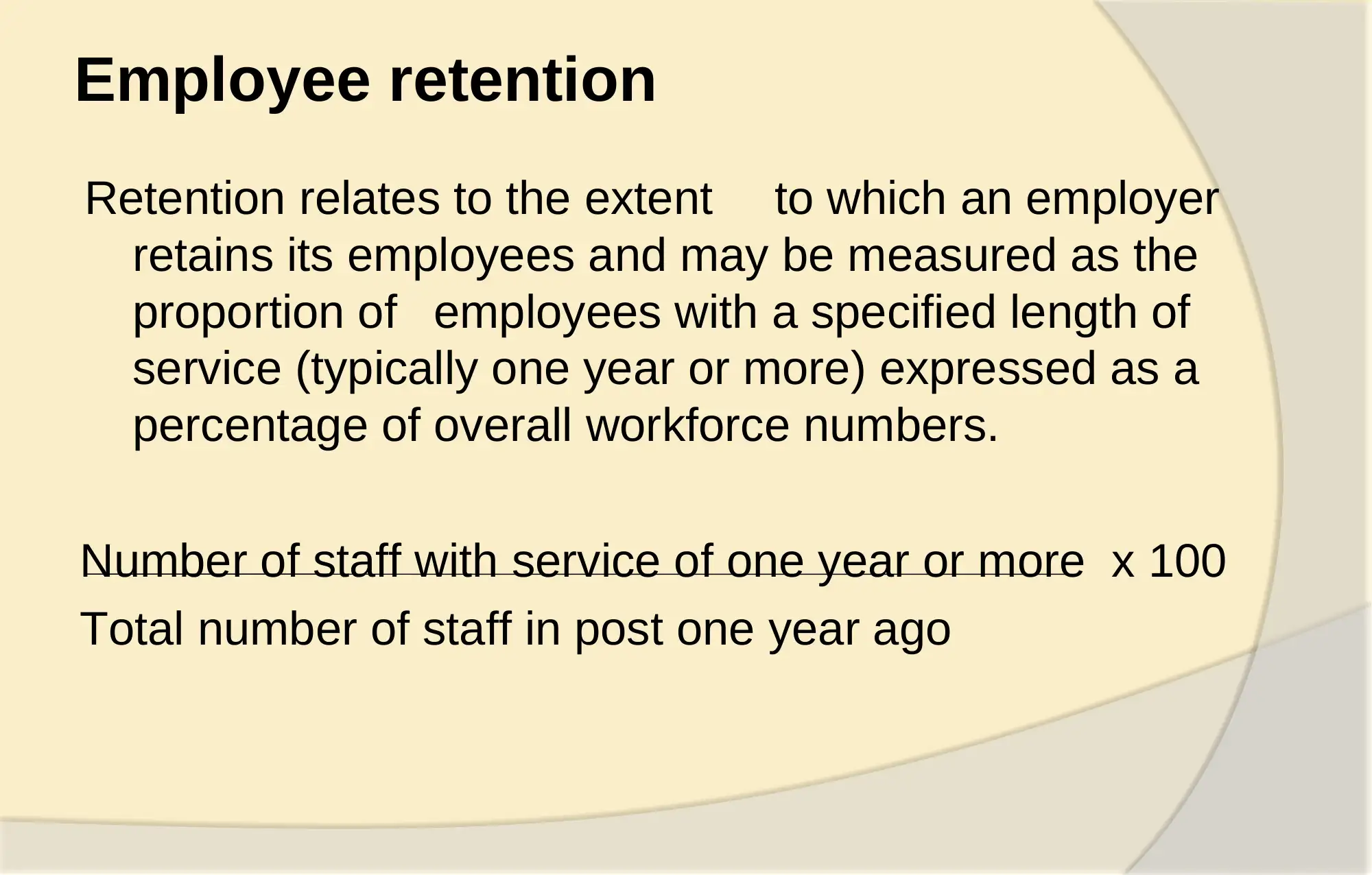
Employee retention
Retention relates to the extent to which an employer
retains its employees and may be measured as the
proportion of employees with a specified length of
service (typically one year or more) expressed as a
percentage of overall workforce numbers.
Number of staff with service of one year or more x 100
Total number of staff in post one year ago
Retention relates to the extent to which an employer
retains its employees and may be measured as the
proportion of employees with a specified length of
service (typically one year or more) expressed as a
percentage of overall workforce numbers.
Number of staff with service of one year or more x 100
Total number of staff in post one year ago
Secure Best Marks with AI Grader
Need help grading? Try our AI Grader for instant feedback on your assignments.
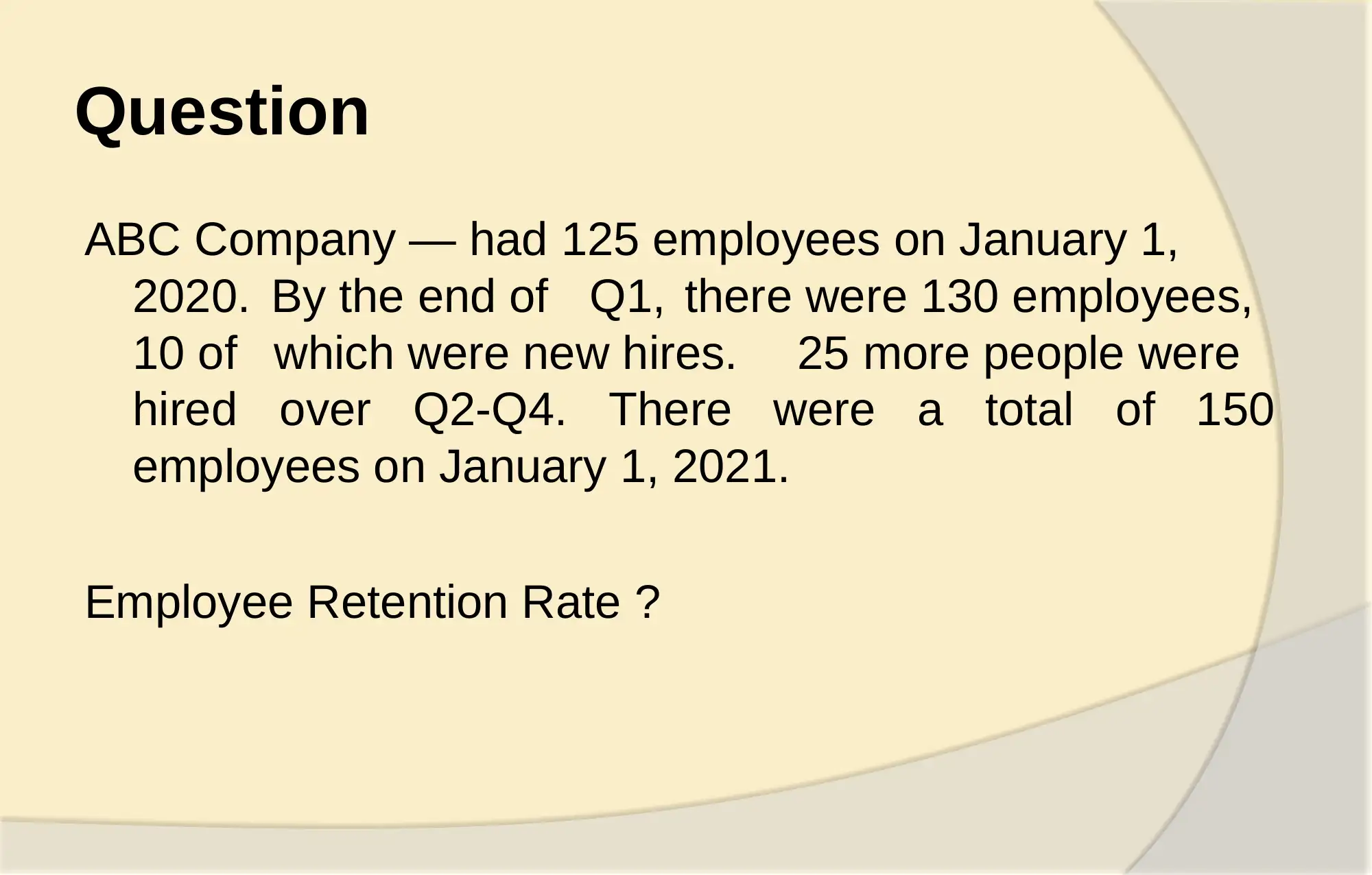
Question
ABC Company — had 125 employees on January 1,
2020. By the end of Q1, there were 130 employees,
10 of which were new hires. 25 more people were
hired over Q2-Q4. There were a total of 150
employees on January 1, 2021.
Employee Retention Rate ?
ABC Company — had 125 employees on January 1,
2020. By the end of Q1, there were 130 employees,
10 of which were new hires. 25 more people were
hired over Q2-Q4. There were a total of 150
employees on January 1, 2021.
Employee Retention Rate ?
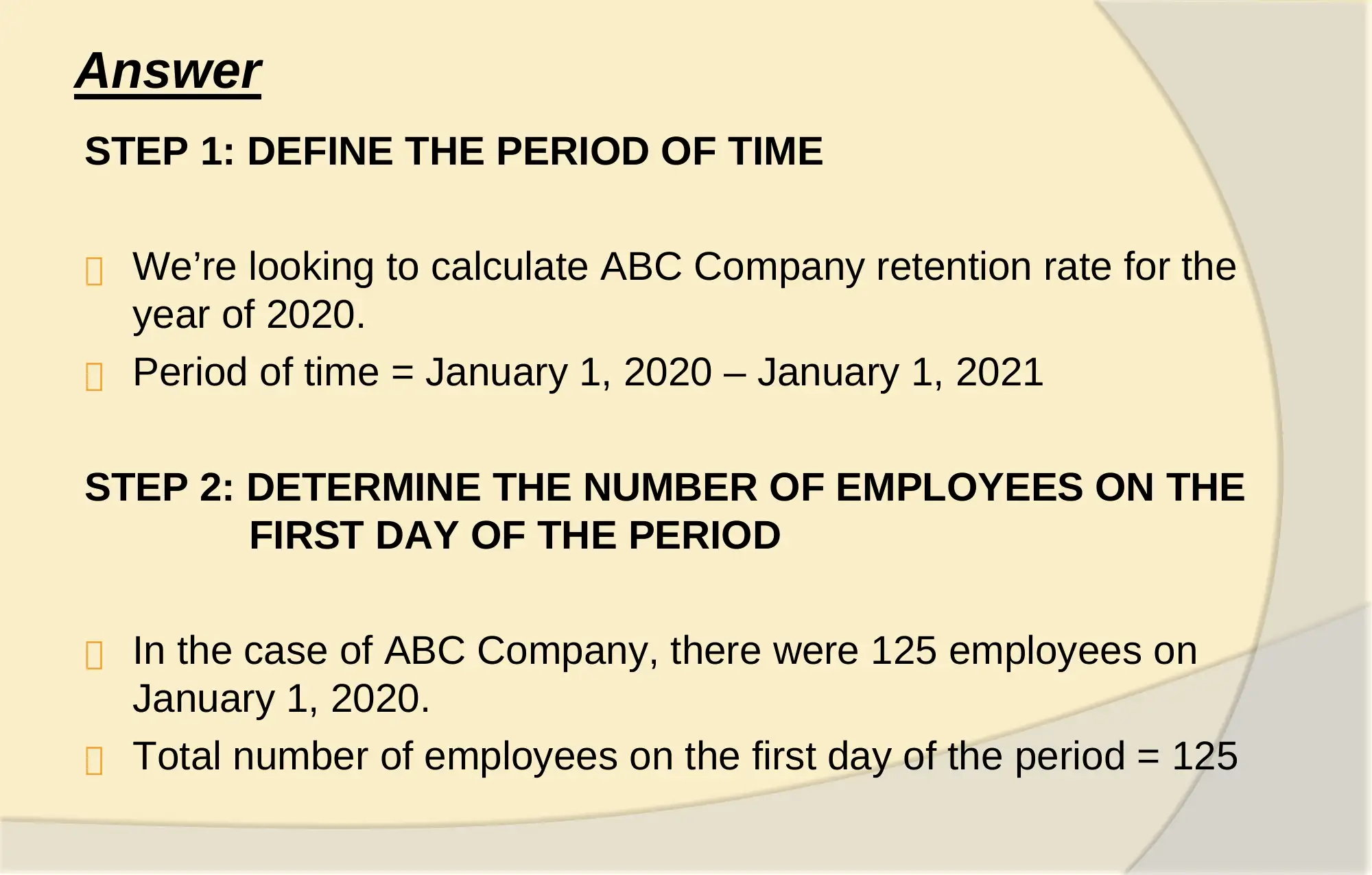
Answer
STEP 1: DEFINE THE PERIOD OF TIME
We’re looking to calculate ABC Company retention rate for the
year of 2020.
Period of time = January 1, 2020 – January 1, 2021
STEP 2: DETERMINE THE NUMBER OF EMPLOYEES ON THE
FIRST DAY OF THE PERIOD
In the case of ABC Company, there were 125 employees on
January 1, 2020.
Total number of employees on the first day of the period = 125
STEP 1: DEFINE THE PERIOD OF TIME
We’re looking to calculate ABC Company retention rate for the
year of 2020.
Period of time = January 1, 2020 – January 1, 2021
STEP 2: DETERMINE THE NUMBER OF EMPLOYEES ON THE
FIRST DAY OF THE PERIOD
In the case of ABC Company, there were 125 employees on
January 1, 2020.
Total number of employees on the first day of the period = 125
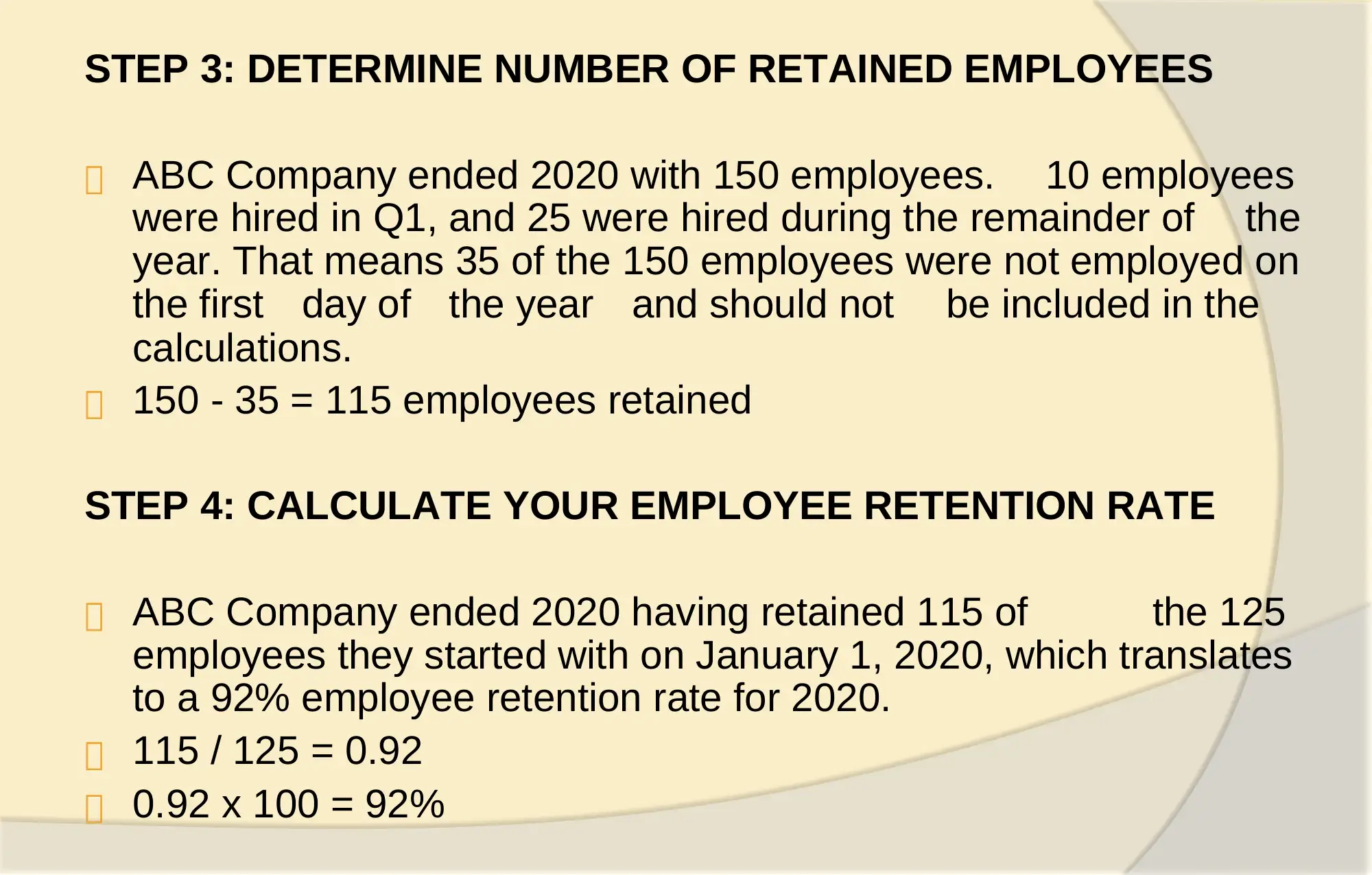
STEP 3: DETERMINE NUMBER OF RETAINED EMPLOYEES
ABC Company ended 2020 with 150 employees. 10 employees
were hired in Q1, and 25 were hired during the remainder of the
year. That means 35 of the 150 employees were not employed on
the first day of the year and should not be included in the
calculations.
150 - 35 = 115 employees retained
STEP 4: CALCULATE YOUR EMPLOYEE RETENTION RATE
ABC Company ended 2020 having retained 115 of the 125
employees they started with on January 1, 2020, which translates
to a 92% employee retention rate for 2020.
115 / 125 = 0.92
0.92 x 100 = 92%
ABC Company ended 2020 with 150 employees. 10 employees
were hired in Q1, and 25 were hired during the remainder of the
year. That means 35 of the 150 employees were not employed on
the first day of the year and should not be included in the
calculations.
150 - 35 = 115 employees retained
STEP 4: CALCULATE YOUR EMPLOYEE RETENTION RATE
ABC Company ended 2020 having retained 115 of the 125
employees they started with on January 1, 2020, which translates
to a 92% employee retention rate for 2020.
115 / 125 = 0.92
0.92 x 100 = 92%
Paraphrase This Document
Need a fresh take? Get an instant paraphrase of this document with our AI Paraphraser

1 out of 26
Related Documents
Your All-in-One AI-Powered Toolkit for Academic Success.
+13062052269
info@desklib.com
Available 24*7 on WhatsApp / Email
![[object Object]](/_next/static/media/star-bottom.7253800d.svg)
Unlock your academic potential
© 2024 | Zucol Services PVT LTD | All rights reserved.





